Lochinvar WH 55-399 User Manual
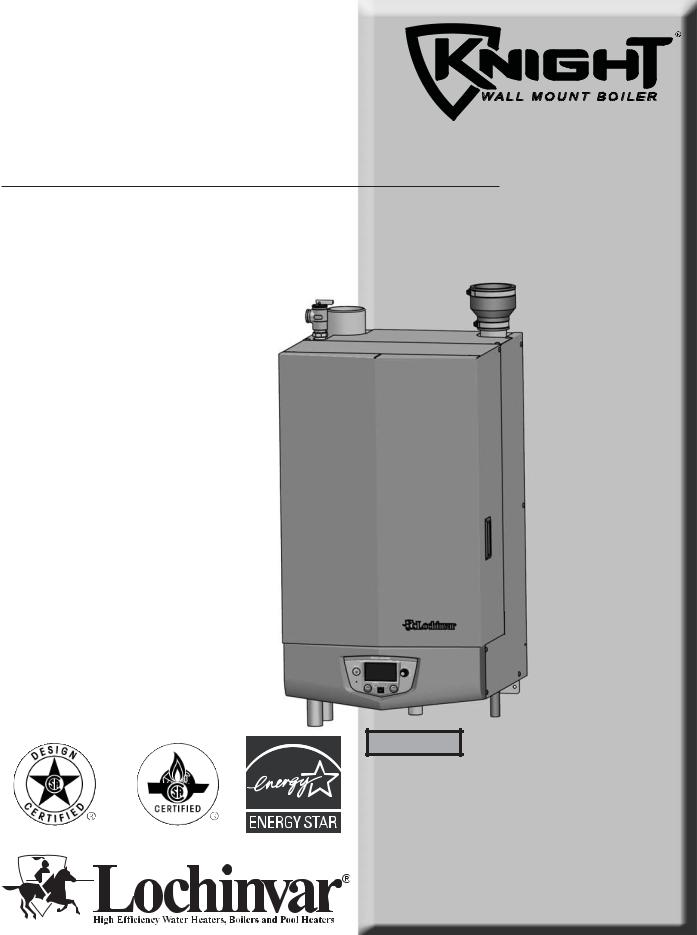
WH-I-O Rev H
Installation & Operation Manual
Models: WH 55 - 399
WARNING This manual must only be used by a qualified heating installer / service technician. Read all instructions, including this manual and the Knight Wall Mount Service Manual, before installing. Perform steps in the order given. Failure to comply could result in severe personal injury, death, or substantial property damage.
Save this manual for future reference.
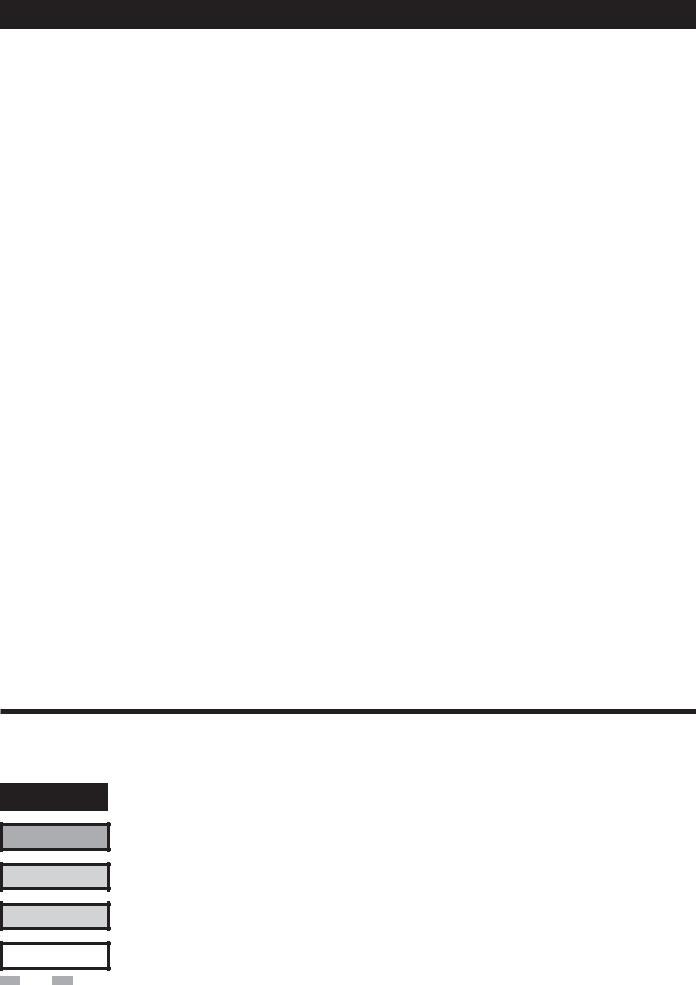
Contents
HAZARD DEFINITIONS . . . . . . . . . . . . . . . . . . . . . . . |
. . . 2 |
PLEASE READ BEFORE PROCEEDING . . . . . . . . . |
. . . 3 |
THE KNIGHT WALL MOUNT BOILER-- HOW IT WORKS . 4-5 |
|
RATINGS . . . . . . . . . . . . . . . . . . . . . . . . . . . . . . . . . . . |
. . . 6 |
1. DETERMINE BOILER LOCATION |
|
Provide Clearances . . . . . . . . . . . . . . . . . . . . . . . . . . . |
. . . 7 |
Provide Air Openings to Room . . . . . . . . . . . . . . . . . . |
. . . 9 |
Wall Mounting Location . . . . . . . . . . . . . . . . . . . . . . . . |
. . 9 |
Residential Garage Installation . . . . . . . . . . . . . . . . . . |
. . . 9 |
Vent and Air Piping . . . . . . . . . . . . . . . . . . . . . . . . . . . |
. . . 9 |
Prevent Combustion Air Contamination. . . . . . . . . . . . |
. . . 9 |
Corrosive Contaminants and Sources . . . . . . . . . . . . . |
. . 10 |
Using an Existing Vent System to Install a New Boiler |
. . 10 |
Removing a Boiler from Existing Common Vent . . . . . |
. . 11 |
2. PREPARE BOILER |
|
Remove Boiler from Wood Pallet. . . . . . . . . . . . . . . . . |
. . 12 |
Gas Conversions . . . . . . . . . . . . . . . . . . . . . . . . . . . . . |
. . 12 |
Mounting the Boiler . . . . . . . . . . . . . . . . . . . . . . . . . . . |
. . 13 |
3. GENERAL VENTING |
|
Direct Venting Options ..................................................... |
14 |
Install Vent and Combustion Air Piping ........................... |
15 |
Requirements for Installation in Canada.......................... |
16 |
Sizing ............................................................................... |
16 |
Materials............................................................................ |
17 |
Optional Room Air............................................................ |
18 |
PVC/CPVC ....................................................................... |
19 |
Polypropylene................................................................... |
20 |
Stainless Steel Vent ......................................................... |
21 |
4. SIDEWALL DIRECT VENTING |
|
Vent/Air Termination - Sidewall................................... |
22-28 |
Determine Location................................................ |
22-24 |
Prepare Wall Penetrations.......................................... |
24 |
Multiple Vent/Air Terminations ......................................... |
25 |
Sidewall Termination - Optional Concentric Vent ....... |
26-28 |
5. VERTICAL DIRECT VENTING |
|
Vent/Air Termination - Vertical .................................... |
29-30 |
Determine Location..................................................... |
29 |
Prepare Roof Penetrations ......................................... |
29 |
Multiple Vent/Air Terminations.................................... |
30 |
Vertical Termination - Optional Concentric Vent ... |
30-31 |
Alternate Vertical Concentric Venting......................... |
32 |
6. HYDRONIC PIPING
System Water Piping Methods. . . . . . . . . . . . . . . . . . . . . 33
Low Water Cutoff Device . . . . . . . . . . . . . . . . . . . . . . . . . 33
Chilled Water System. . . . . . . . . . . . . . . . . . . . . . . . . . . . 33
Freeze Protection. . . . . . . . . . . . . . . . . . . . . . . . . . . . . . . 33
General Piping Information . . . . . . . . . . . . . . . . . . . . . . . 33
Near Boiler Piping Components. . . . . . . . . . . . . . . . . . . . 34
Near Boiler Piping Connections . . . . . . . . . . . . . . . . . . . . 35
Circulator Sizing . . . . . . . . . . . . . . . . . . . . . . . . . . . . . . . . 35
Variable Speed Pump Option . . . . . . . . . . . . . . . . . . . . . 37
7. GAS CONNECTIONS
Connecting Gas Supply Piping . . . . . . . . . . . . . . . . . . . . 48
Natural Gas . . . . . . . . . . . . . . . . . . . . . . . . . . . . . . . . . . . 49
Pipe Sizing for Natural Gas . . . . . . . . . . . . . . . . . . . . 49
Natural Gas Supply Pressure Requirements . . . . . . . 49
Propane Gas . . . . . . . . . . . . . . . . . . . . . . . . . . . . . . . . . . 49
Pipe Sizing for Propane Gas . . . . . . . . . . . . . . . . . . . 49
Propane Supply Pressure Requirements . . . . . . . . . . 49
Check Inlet Gas Supply . . . . . . . . . . . . . . . . . . . . . . . . . . 50
Gas Pressure . . . . . . . . . . . . . . . . . . . . . . . . . . . . . . . . . . 51
Gas Valve Replacement . . . . . . . . . . . . . . . . . . . . . . . . . 51
8. FIELD WIRING
Line Voltage Connections . . . . . . . . . . . . . . . . . . . . . . . . 52
Low Voltage Connections . . . . . . . . . . . . . . . . . . . . . . . . 52
Wiring of the Cascade . . . . . . . . . . . . . . . . . . . . . . . . . . . 54
9. CONDENSATE DISPOSAL
Condensate Drain . . . . . . . . . . . . . . . . . . . . . . . . . . . . . . 56
10. STARTUP . . . . . . . . . . . . . . . . . . . . . . . . . . . . . . 57-63
11. OPERATING INFORMATION
General. . . . . . . . . . . . . . . . . . . . . . . . . . . . . . . . . . . . . . . 64
Cascade . . . . . . . . . . . . . . . . . . . . . . . . . . . . . . . . . . . . . . 67
Sequence of Operation . . . . . . . . . . . . . . . . . . . . . . . 68-69
Knight Wall Mount Boiler Control Module . . . . . . . . . . . . 70
Status Display Screens . . . . . . . . . . . . . . . . . . . . . . . 71-73
12. MAINTENANCE
Maintenance and Annual Startup. . . . . . . . . . . . . . . . 74-77
13. DIAGRAMS
Ladder Diagram . . . . . . . . . . . . . . . . . . . . . . . . . . . . . . . . 78
Wiring Diagram. . . . . . . . . . . . . . . . . . . . . . . . . . . . . . . . . 79
Revision Notes . . . . . . . . . . . . . . . . . . . . . . . . . Back Cover
Hazard definitions
The following defined terms are used throughout this manual to bring attention to the presence of hazards of various risk levels or to important information concerning the life of the product.
DANGER indicates an imminently hazardous situation which, if not avoided, will result in death or serious injury.
WARNING indicates a potentially hazardous situation which, if not avoided, could result in death or serious injury.
CAUTION indicates a potentially hazardous situation which, if not avoided, may result in minor or moderate injury.
CAUTION used without the safety alert symbol indicates a potentially hazardous situation which, if not avoided, may result in property damage.
NOTICE indicates special instructions on installation, operation, or maintenance that are important but not related to personal injury or property damage.
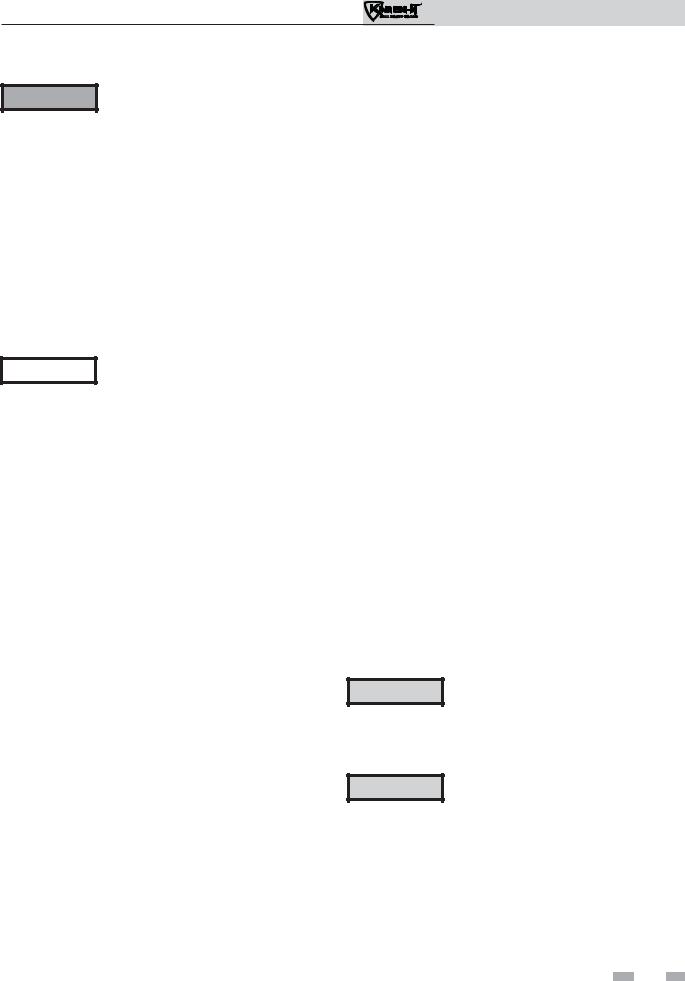
Installation & Operation Manual
Please read before proceeding
WARNING
NOTICE
Installer – Read all instructions, including this manual and the Knight Wall Mount Service Manual, before installing. Perform steps in the order given.
User – This manual is for use only by a qualified heating installer/ service technician. Refer to the User’s Information Manual for your reference.
Have this boiler serviced/inspected by a qualified service technician, at least annually.
Failure to comply with the above could result in severe personal injury, death or substantial property damage.
When calling or writing about the boiler
– Please have the boiler model and serial number from the boiler rating plate.
Consider piping and installation when determining boiler location.
When servicing boiler –
•To avoid electric shock, disconnect electrical supply before performing maintenance.
•To avoid severe burns, allow boiler to cool before performing maintenance.
Boiler operation –
•Do not block flow of combustion or ventilation air to the boiler.
•Should overheating occur or gas supply fail to shut off, do not turn off or disconnect electrical supply to circulator. Instead, shut off the gas supply at a location external to the appliance.
•Do not use this boiler if any part has been under water. The possible damage to a flooded appliance can be extensive and present numerous safety hazards. Any appliance that has been under water must be replaced.
|
Any claims for damage or shortage in |
|
shipment must be filed immediately |
|
against the transportation company by |
|
the consignee. |
|
Factory warranty (shipped with unit) |
|
does not apply to units improperly |
|
installed or improperly operated. |
|
Failure to adhere to the guidelines on this |
WARNING |
|
|
page can result in severe personal injury, |
|
|
|
death, or substantial property damage. |
|
If the information in this manual is not |
WARNING |
|
|
followed exactly, a fire or explosion may |
|
result causing property damage, personal |
|
injury or loss of life. |
|
This appliance MUST NOT be installed |
|
in any location where gasoline or |
|
flammable vapors are likely to be present. |
|
WHAT TO DO IF YOU SMELL GAS |
|
• Do not try to light any appliance. |
|
• Do not touch any electric switch; do |
|
not use any phone in your building. |
|
• Immediately call your gas supplier |
|
from a near by phone. Follow the |
|
gas supplier’s instructions. |
|
• If you cannot reach your gas supplier, |
|
call the fire department. |
|
• Installation and service must be |
|
performed by a qualified installer, |
|
service agency, or the gas supplier. |
Boiler water –
•Thoroughly flush the system (without boiler connected) to remove sediment. The high-efficiency heat exchanger can be damaged by build-up or corrosion due to sediment.
•Continual fresh make-up water will reduce boiler life. Mineral buildup in the heat exchanger reduces heat transfer, overheats the stainless steel heat exchanger, and causes failure. Addition of oxygen carried in by makeup water can cause internal corrosion in system components. Leaks in boiler or piping must be repaired at once to prevent makeup water.
CAUTION Do not use petroleum-based cleaning or sealing compounds in the boiler system.
Gaskets and seals in the system may be damaged. This can result in substantial property damage.
Do not use “homemade cures” or “boilerCAUTION patent medicines”. Serious damage to
the boiler, personnel, and/or property may result.
Freeze protection fluids –
•NEVER use automotive antifreeze. Use only inhibited propylene glycol solutions, which are specifically formulated for hydronic systems. Ethylene glycol is toxic and can attack gaskets and seals used in hydronic systems.
3
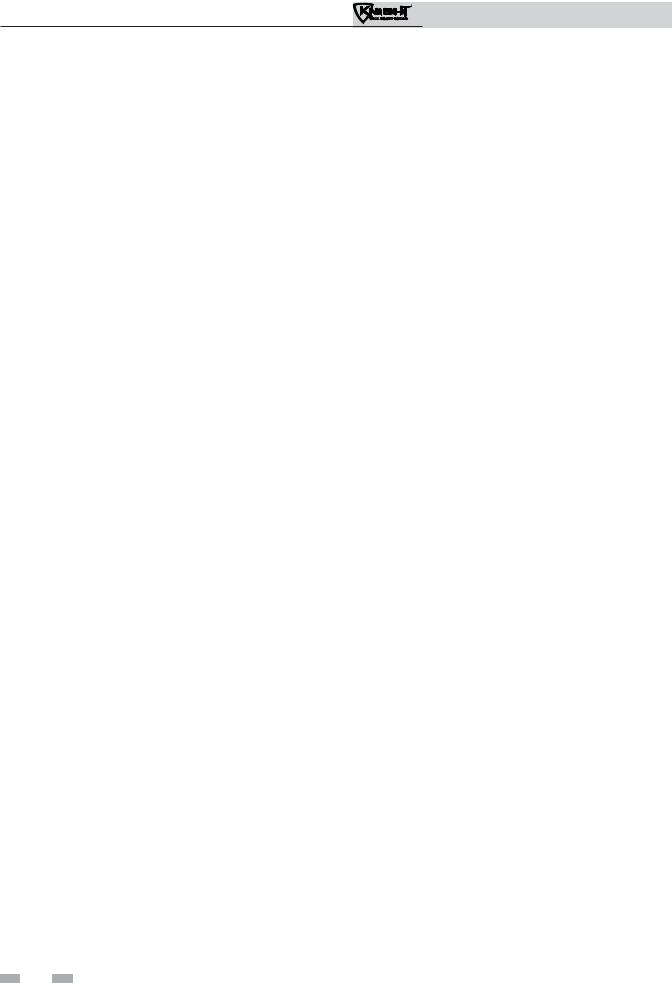
Installation & Operation Manual
The Knight Wall Mount Boiler - How it works...
1.Stainless steel heat exchanger
Allows system water to flow around specially designed tubes for maximum heat transfer, while providing protection against flue gas corrosion.
2.Combustion chamber access cover
Allows access to the combustion side of the heat exchanger.
3.Blower
15.Gas connection pipe
Threaded pipe connection. This pipe should be connected to the incoming gas supply for the purpose of delivering gas to the boiler.
16.SMART SYSTEM Control Module
The SMART SYSTEM Control responds to internal and external signals and controls the blower, gas valve, and pumps to meet the heating demand.
The blower pulls in air and gas through the venturi (item 5). Air and gas mix inside the blower and are pushed into the burner, where they burn inside the combustion chamber.
4.Gas valve
17.Air intake adapter
Allows for the connection of the PVC air intake pipe to the boiler.
18.High voltage junction box
The gas valve senses the negative pressure created by the blower, allowing gas to flow only if the gas valve is powered and combustion air is flowing.
5.Venturi
The venturi controls air and gas flow into the burner.
6.Flue gas sensor (limit rated)
This sensor monitors the flue gas exit temperature. The control module will modulate and shut down the boiler if flue gas temperature gets too hot. This protects the flue pipe from overheating.
7.Boiler outlet temperature sensor (housed with high limit sensor)
This sensor monitors boiler outlet water temperature (system supply). If selected as the controlling sensor, the control module adjusts boiler firing rate so the outlet temperature is correct.
8.Boiler inlet temperature sensor
This sensor monitors return water temperature (system return). If selected as the controlling sensor, the control module adjusts the boiler firing rate so the inlet temperature is correct.
9.Temperature and pressure gauge (field installed, not shown)
Monitors the outlet temperature of the boiler as well as the system water pressure.
10.Electronic LCD display
The electronic display consists of 4 buttons, a navigation dial and a multiple line liquid crystal display.
11.Flue pipe adapter
Allows for the connection of the PVC vent pipe system to the boiler.
12.Burner (not shown)
Made with metal fiber and stainless steel construction, the burner uses pre-mixed air and gas and provides a wide range of firing rates.
13.Water outlet (system supply)
The water outlet is the water connection for water leaving the boiler and entering the system.
14.Water inlet (system return)
The water inlet is the water connection for water entering the boiler from the system.
4
The junction box contains the connection points for the line voltage power and all pumps.
19.Low voltage connection board
The connection board is used to connect external low voltage devices.
20.Low voltage wiring connections (knockouts)
Conduit connection points for the low voltage connection board.
21.Condensate drain connection
Connects the condensate drain line.
22.Access door
Provides access to all internal components.
23.Ignition electrode
Provides direct spark for igniting the burner.
24.Flame inspection window
The quartz glass window provides a view of the burner surface and flame.
25.Gas shutoff switch
An electrical switch designed to cut power to the gas valve to prevent releasing any gas.
26.High limit sensor (housed with outlet sensor)
Device that monitors the outlet water temperature. If the temperature exceeds its setting, it will break the control circuit, shutting the boiler down.
27.Relief valve
Protects the heat exchanger from an over pressure condition. The relief valve provided with the unit is set at 30 psi.
28.Flame sensor
Used by the control module to detect the presence of burner flame.
29.Line voltage wiring connections (knockouts)
Conduit connection points for the high voltage junction box.
30.Transformer
The transformer provides 24V power to the integrated control.
31.ModBus
The optional ModBus option provides intelligent building system communications.
32.On/Off switch
The On/Off switch is used to turn 120 VAC on and off to the unit.
33.Manual air vent
Allows for removal of trapped air from the heat exchanger.
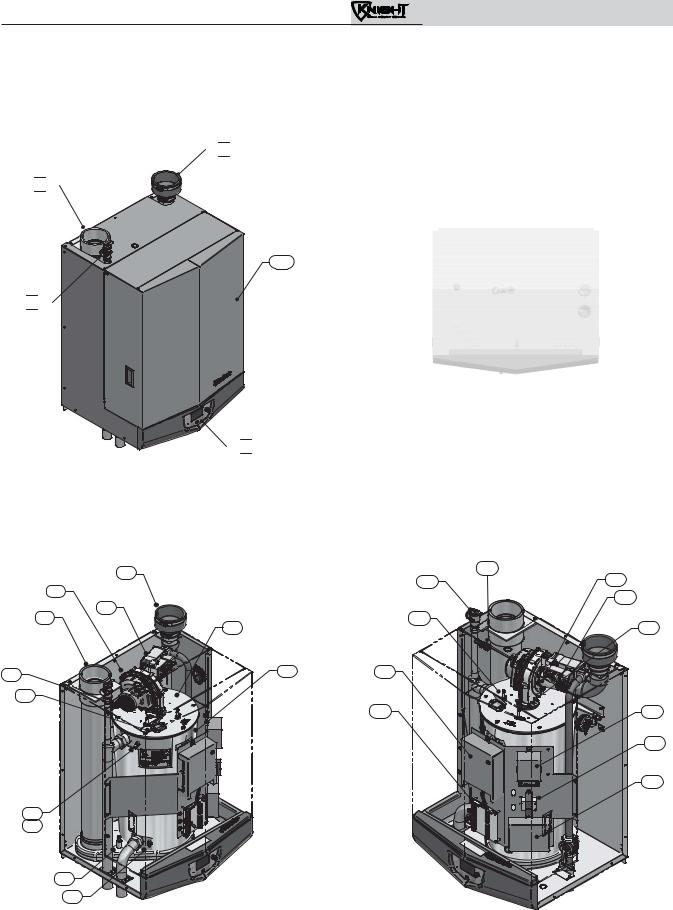
Installation & Operation Manual
The Knight Wall Mount Boiler - How it works... (continued)
Models 55 - 399
 17
17
 11
11
|
21 |
|
15 |
22 |
13 |
|
14 |
 28
28
29
32 |
20 |
FRONT OF UNIT |
IMG00117
 10
10
Front View |
Bottom View |
|
17 |
|
33 |
|
27 |
5 |
|
|
3 |
||
|
|
25 |
|
|
4 |
|
|
|
|
|
|
|
11 |
23 |
|
|
2 |
|
28 |
33 |
1 |
16 |
|
|
|
|
|
|
24 |
|
|
|
|
19 |
31 |
|
|
|
30 |
|
|
|
18 |
7
26
6 |
IMG00162 |
8 |
IMG00161 |
Left Side (inside unit) Right Side (inside unit)
5

Installation & Operation Manual
Ratings
A
SME
H
Knight Wall Mount Boiler
AHRI Rating
|
|
Input |
|
Heating |
Net |
|
|
Model Number |
|
|
Capacity |
AHRI |
AFUE |
||
|
MBH |
|
MBH |
Ratings |
% |
||
|
|
|
|
|
|||
Note: Change |
|
(Note 5) |
|
|
Water, |
|
|
“N” to “L” for |
|
|
|
|
|
MBH |
|
L.P. gas models. |
|
|
|
|
|
|
|
|
Min |
|
Max |
|
(Note 2, 8) |
(Note 3, 8) |
(Note 1, 8) |
WHN055 |
11 |
|
55 |
51 |
44 |
96 |
|
|
|
|
|
|
|
|
|
WHN085 |
17 |
|
85 |
79 |
69 |
96 |
|
|
|
|
|
|
|
|
|
WHN110 |
22 |
|
110 |
102 |
89 |
96 |
|
|
|
|
|
|
|
|
|
WHN155 |
31 |
|
155 |
144 |
125 |
96 |
|
|
|
|
|
|
|
|
|
WHN199 |
40 |
|
199 |
186 |
162 |
96 |
|
|
|
|
|
|
|
|
|
WHN285 |
57 |
|
285 |
265 |
230 |
96 |
|
|
|
|
|
|
|
|
|
WHN399 |
80 |
|
399 |
379 |
330 |
95 |
|
|
|
|
|
|
|
|
|
Other Specifications
|
|
|
Vent/Air |
Boiler Water |
Water |
Gas |
Size |
Content |
|
||
Connections |
Connections |
|
|
Gallons |
|
||
|
|
|
|
|
|
|
(Note 4) |
|
|
|
|
2.5 |
1" |
1/2" |
2" |
|
|
|
|
2.5 |
1" |
1/2" |
2" |
|
|
|
|
3.5 |
1" |
1/2" |
3" |
|
|
|
|
3.5 |
1" |
1/2" |
3" |
|
|
|
|
5.0 |
1 1/4" |
1/2" |
3" |
|
|
|
|
5.0 |
1 1/4" |
1/2" |
3" |
|
|
|
|
6.5 |
1 1/2" |
3/4" |
4" |
|
|
|
|
|
NOTICE |
Maximum allowed working pressure is located on the rating plate. |
||||
Notes: |
|
|
|
7. The Knight Wall Mount boiler input rate, on some models, |
||
|
|
|
is reduced for vent lengths beyond the minimum. Two inch |
|||
1. As an Energy Star Partner, Lochinvar has determined that |
||||||
vent will reduce Models WH(N,L) 055, WH(N,L) 085 and |
||||||
|
Knight wall mount boilers meet the Energy Star guidelines |
|||||
|
WH(N,L)110 by 0.6%, 0.94%, and 1.2% for every 10 feet |
|||||
|
for energy efficiency. |
|
|
|||
|
|
|
of vent. Three inch vent will reduce Models WH(N,L)155, |
|||
2. The ratings are based on standard test procedures prescribed |
||||||
WH(N,L)199 and WH(N,L) 285 by 0.3%, 0.5%, and 0.6% |
||||||
|
by the United States Department of Energy. |
|
for every 10 feet of vent. Four inch vent will reduce Model |
|||
3. Net AHRI ratings are based on net installed radiation of |
WH(N,L) 399 by 0.4% for every 10 feet of vent. |
|||||
|
sufficient quantity for the requirements of the building |
8. Ratings have been confirmed by the Hydronics Section of |
||||
|
and nothing need be added for normal piping and pickup. |
AHRI. Model 399 has a thermal efficiency rating. |
||||
|
Ratings are based on a piping and pickup allowance of 1.15. |
9. Knight wall mount boilers comply with the requirements |
||||
4. |
Knight wall mount boilers require special gas venting. Use |
of CSD-1 Section CW-400 requirements as a temperature |
||||
|
only the vent materials and methods specified in the Knight |
operation control. The manual reset high limit provided |
||||
|
Wall Mount Installation and Operation Manual. |
|
with the Knight wall mount boiler is listed to UL353. |
|||
5. Standard Knight wall mount boilers are equipped to operate |
|
|||||
|
from sea level to 4,500 feet only with no adjustments. The |
|
||||
|
boiler will de-rate by 4% for each 1,000 feet above sea level |
|
||||
|
up to 4,500 feet. |
|
|
|
||
6. |
High altitude Knight |
wall mount boilers are |
equipped |
UNIT EQUIPPED FOR |
||
|
to operate |
from 3,000 |
to 12,000 feet only with |
no field |
HIGH ALTITUDE |
|
|
|
|
|
|
||
|
adjustments. The boiler will de-rate by 2% for each 1,000 |
3,000FT TO 12,000FT |
||||
|
feet above 3,000 feet. High altitude models are manufactured |
|
||||
|
with a different control module for altitude operation, but |
|
||||
|
the operation given in this manual remains the same as the |
|
||||
|
standard boilers. A high altitude label (as shown in FIG. A) |
|
||||
|
is also affixed to the unit. |
|
|
|||
|
6 |
|
|
|
Figure A High Altitude Label Location |
|
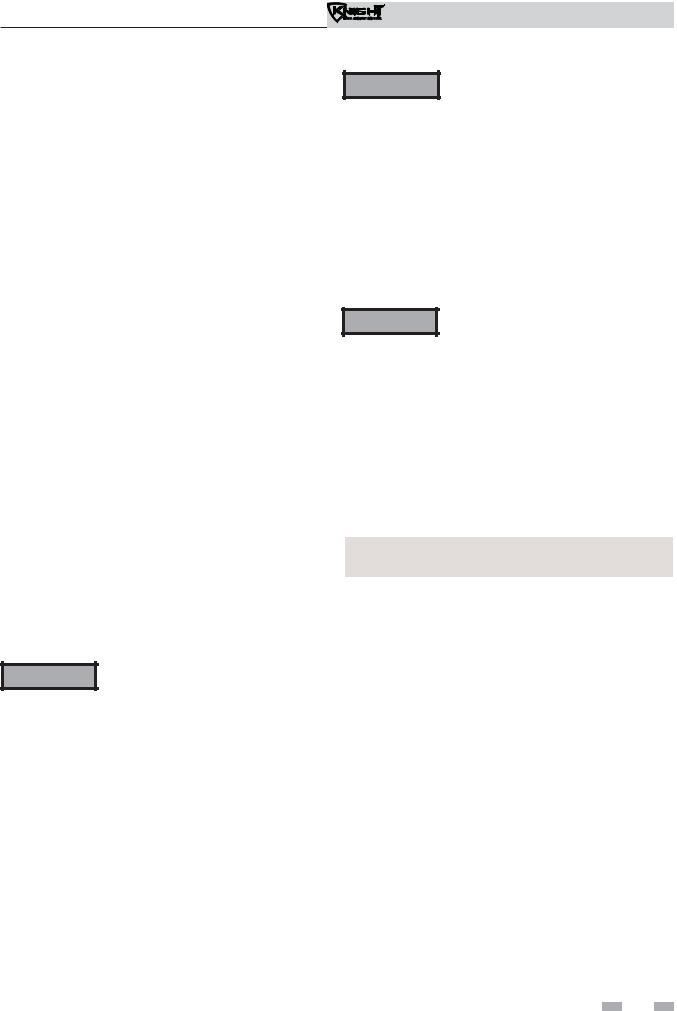
Installation & Operation Manual
1 Determine boiler location
Installation must comply with:
•Local, state, provincial, and national codes, laws, regulations, and ordinances.
•National Fuel Gas Code, ANSI Z223.1 – latest edition.
•Standard for Controls and Safety Devices for Automatically Fired Boilers, ANSI/ASME CSD-1, when required.
•National Electrical Code.
•For Canada only: B149.1 Installation Code, CSA C22.1 Canadian Electrical Code Part 1 and any local codes.
NOTICE |
The Knight wall mount boiler gas |
|
manifold and controls met safe lighting |
||
|
||
|
and other performance criteria when the |
|
|
boiler underwent tests specified in ANSI |
|
|
Z21.13 – latest edition. |
Before locating the boiler, check:
1.Check for nearby connection to:
•System water piping
•Venting connections
•Gas supply piping
•Electrical power
2.Locate the appliance so that if water connections should leak, water damage will not occur. When such locations cannot be avoided, it is recommended that a suitable drain pan, adequately drained, be installed under the appliance. The pan must not restrict combustion air flow. Under no circumstances is the manufacturer to be held responsible for water damage in connection with this appliance, or any of its components.
3.Check area around the boiler. Remove any combustible materials, gasoline and other flammable liquids.
Failure to keep boiler area clear and freeWARNING of combustible materials, gasoline, and other flammable liquids and vapors can result in severe personal injury, death, or
substantial property damage.
4.The Knight wall mount boiler must be installed so that gas control system components are protected from dripping or spraying water or rain during operation or service.
5.If a new boiler will replace an existing boiler, check for and correct system problems, such as:
•System leaks causing oxygen corrosion or heat exchanger cracks from hard water deposits.
•Incorrectly-sized expansion tank.
•Lack of freeze protection in boiler water causing system and boiler to freeze and leak.
WARNING
WARNING
This appliance is certified as an indoor appliance. Do not install the appliance outdoors or locate where the appliance will be exposed to freezing temperatures or to temperatures that exceed 100°F.
Do not install the appliance where the relative humidity may exceed 93%. Do not install the appliance where condensation may form on the inside or outside of the appliance, or where condensation may fall onto the appliance.
Failure to install the appliance indoors could result in severe personal injury, death, or substantial property damage.
This appliance requires a special venting system. The vent connection to the appliance is made of CPVC. Field supplied vent fittings must be cemented to the CPVC fitting on the boiler. Use only the vent materials, primer, and cement specified in the manual to make the vent connections. Failure to follow this warning could result in fire, personal injury, or death.
Closet and alcove installations
A closet is any room the boiler is installed in which the room volume is less than the room volume listed in the table below. An alcove is any room which meets the criteria for a closet, but it does not have a door.
Model |
Room Volume |
||
(in cubic feet) |
|||
|
|
||
55 |
- 85 |
90 |
|
110 |
- 285 |
108 |
|
399 |
178 |
||
Example: Room dimensions = 4 feet long, 4 feet wide, and 9 foot ceiling = 4 x 4 x 9 = 144 cubic feet. This would be considered a closet for the WHN399 model.
WARNING |
For closet and alcove installations as shown |
in FIG.’s 1-1 and 1-2, CPVC or stainless |
|
|
steel vent material must be used inside |
|
the structure. The two ventilating air |
|
openings shown in FIG. 1-1 are required |
|
for this arrangement. Failure to follow |
|
this warning could result in fire, personal |
|
injury, or death. |
Provide clearances:
Clearances from combustible materials
1.Hot water pipes—at least 1/4" from combustible materials.
2.Vent pipe – at least 1" from combustible materials.
3.See FIG.’s 1-1 and 1-2 on page 8 for other clearance minimums.
Clearances for service access
1.See FIG.’s 1-1 and 1-2 on page 8 for recommended service clearances. If you do not provide the minimum clearances shown, it may not be possible to service the boiler without removing it from the space.
7
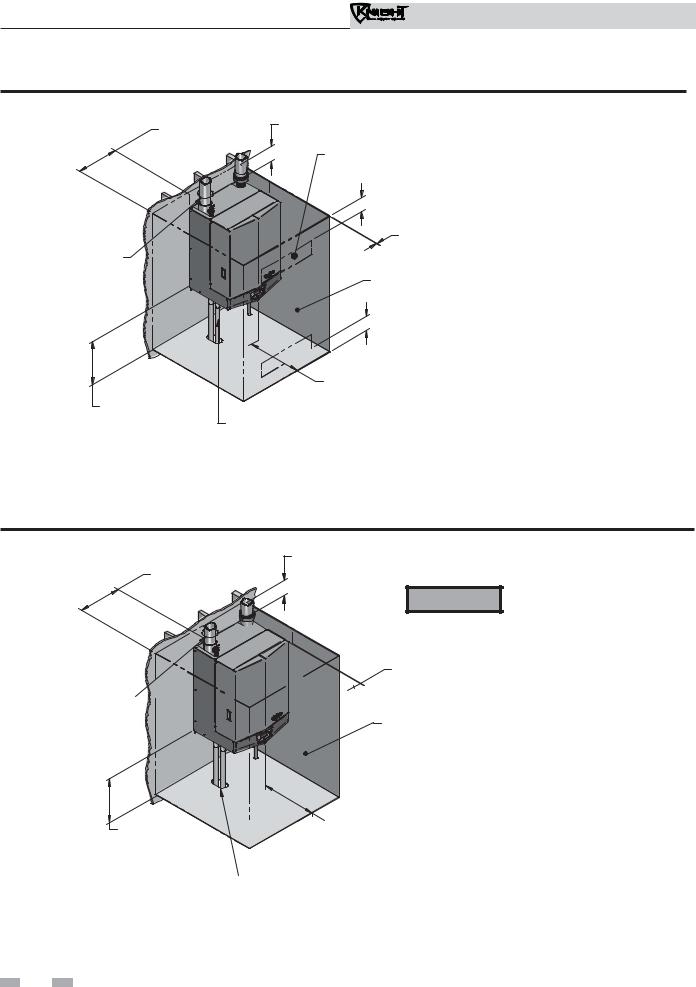
Installation & Operation Manual
1 Determine boiler location
Figure 1-1 Closet Installation - Minimum Required Clearances
LEFT
0" MINIMUM
1" MINIMUM CLEARANCE AROUND VENT PIPE
BOTTOM 0" MINIMUM
TOP |
WARNING |
6" MINIMUM |
|
VENTILATING*
AIR OPENING
6"
RIGHT
0" MINIMUM
CLOSED DOOR
6"

 VENTILATING*
VENTILATING*
AIR OPENING
FRONT
For closet installations, CPVC, polypropylene or stainless steel vent material MUST BE used in a closet structure due to elevated temperatures. Failure to follow this warning could result in fire, personal injury, or death.
6" MINIMUM |
*AREA OF EACH OPENING: |
||||||
|
|
|
|
|
|
|
|
1/4" MINIMUM CLEARANCE |
1 SQ. INCH PER 1000 BTU PER HOUR INPUT |
||||||
AROUND HOT WATER PIPES |
WITH A MINIMUM OF 100 SQ. INCHES. |
||||||
RECOMMENDED SERVICE CLEARANCES:
FRONT: 24” BOTTOM: 24” LEFT SIDE: 12”
Note: Service clearances are recommendations only.
Figure 1-2 Alcove Installation - Minimum Required Clearances
TOP
6" MINIMUM
LEFT
0" MINIMUM
WARNING
RIGHT




 0" MINIMUM 1" MINIMUM CLEARANCE
0" MINIMUM 1" MINIMUM CLEARANCE 


AROUND VENT PIPE
OPEN FRONT
BOTTOM |
|
|
|
|
FRONT |
|
|
|
|
||
|
|
|
|
6" MINIMUM |
|
0" MINIMUM |
|
|
|
|
|
|
|
1/4" MINIMUM CLEARANCE |
|||
|
|
||||
|
|
AROUND HOT WATER PIPES |
|||
For alcove installations, CPVC, polypropylene or stainless steel vent material MUST BE used in an alcove structure due to elevated temperatures. Failure to follow this warning could result in fire, personal injury, or death.
RECOMMENDED SERVICE CLEARANCES:
FRONT: 24” BOTTOM: 24” LEFT SIDE: 12”
Note: Service clearances are recommendations only.
8
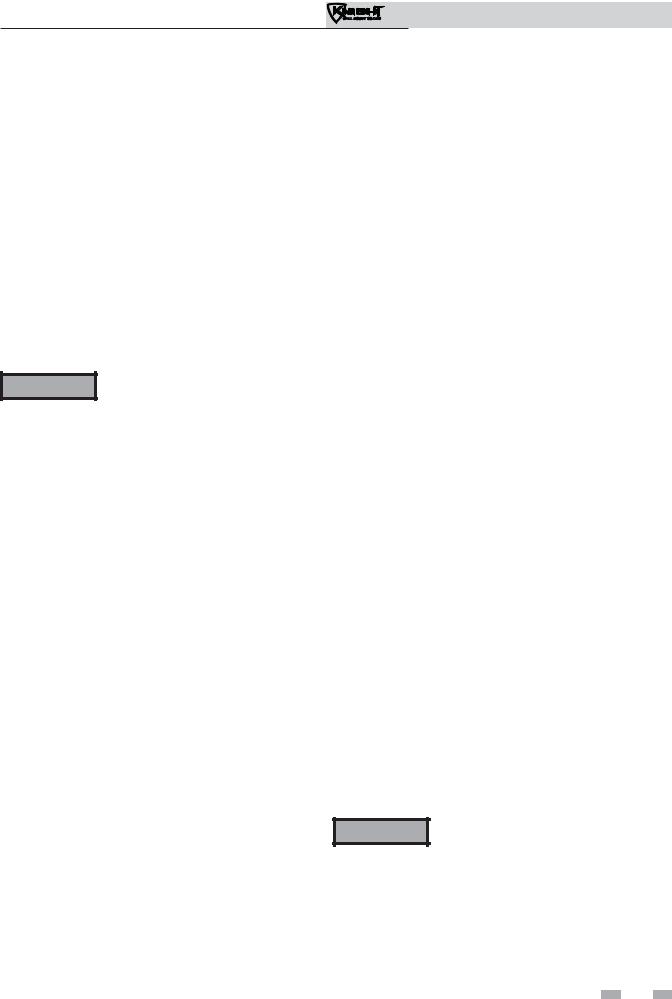
|
Installation & Operation Manual |
1 Determine boiler location (continued) |
|
Provide air openings to room: |
Residential garage installation |
Knight wall mount boiler alone in boiler room
1.No air ventilation openings into the boiler room are needed when clearances around the Knight wall mount boiler are at least equal to the SERVICE clearances shown in FIG.’s 1-1 and 1-2. For spaces that do NOT supply this clearance, provide two openings as shown in FIG. 1-1. Each opening must provide one square inch free area per 1,000 Btu/hr of boiler input.
Knight wall mount boiler in same space with other gas or oil-fired appliances
1. Follow the National Fuel Gas Code (U.S.) or CSA B149.1 (Canada) to size/verify size of the combustion/ ventilation air openings into the space.
WARNING The space must be provided with combustion/ventilation air openings
correctly sized for all other appliances located in the same space as the Knight wall mount boiler.
Do not install the boiler in an attic.
Failure to comply with the above warnings could result in severe personal injury, death, or substantial property damage.
2.Size openings only on the basis of the other appliances in the space. No additional air opening free area is needed for the Knight wall mount boiler because it takes its combustion air from outside (direct vent installation).
Wall mounting location
Ensure the wall for which the boiler is intended to be mounted is comprised of either, cement, brick, block, or wooden studs spaced 16" apart from center. Ensure the wall is capable of supporting at least 250 pounds for Models 55 - 285 and 300 pounds for the 399 Models.
If flooding is possible, elevate the boiler sufficiently to prevent water from reaching the boiler.
Ensure the boiler is installed in a location that minimizes the risk of water damage due to valves, pumps, etc.
Precautions
Take the following precautions when installing the appliance in a residential garage. If the appliance is located in a residential garage, it should be installed in compliance with the latest edition of the National Fuel Gas Code, ANSI Z223.1 and/or CAN/CGA-B149 Installation Code.
•Appliances located in residential garages and in adjacent spaces that open to the garage and are not part of the living space of a dwelling shall be installed so that all burners and burner ignition devices are located not less than 18 inches (46 cm) above the floor.
•The appliance shall be located or protected so that it is not subject to physical damage by a moving vehicle.
Vent and air piping
The Knight wall mount boiler requires a special vent system, designed for pressurized venting.
The boiler is to be used for either direct vent installation or for installation using indoor combustion air. When room air is considered, see Section 3, General Venting. Note prevention of combustion air contamination below when considering vent/ air termination.
Vent and air must terminate near one another and may be vented vertically through the roof or out a side wall, unless otherwise specified. You may use any of the vent/air piping methods covered in this manual. Do not attempt to install the Knight wall mount boiler using any other means.
Be sure to locate the boiler such that the vent and air piping can be routed through the building and properly terminated. The vent/air piping lengths, routing and termination method must all comply with the methods and limits given in this manual.
Prevent combustion air contamination
Install air inlet piping for the Knight wall mount boiler as described in this manual. Do not terminate vent/air in locations that can allow contamination of combustion air. Refer to Table 1A, page 10 for products and areas which may cause contaminated combustion air.
WARNING You must pipe combustion air to the boiler air intake. Ensure that the combustion air will
not contain any of the contaminants in Table 1A, page 10. Contaminated combustion air will damage the boiler, resulting in possible severe personal injury, death or substantial property damage. Do not pipe combustion air near a swimming pool, for example. Also, avoid areas subject to exhaust fumes from laundry facilities. These areas will always
contain contaminants.
9
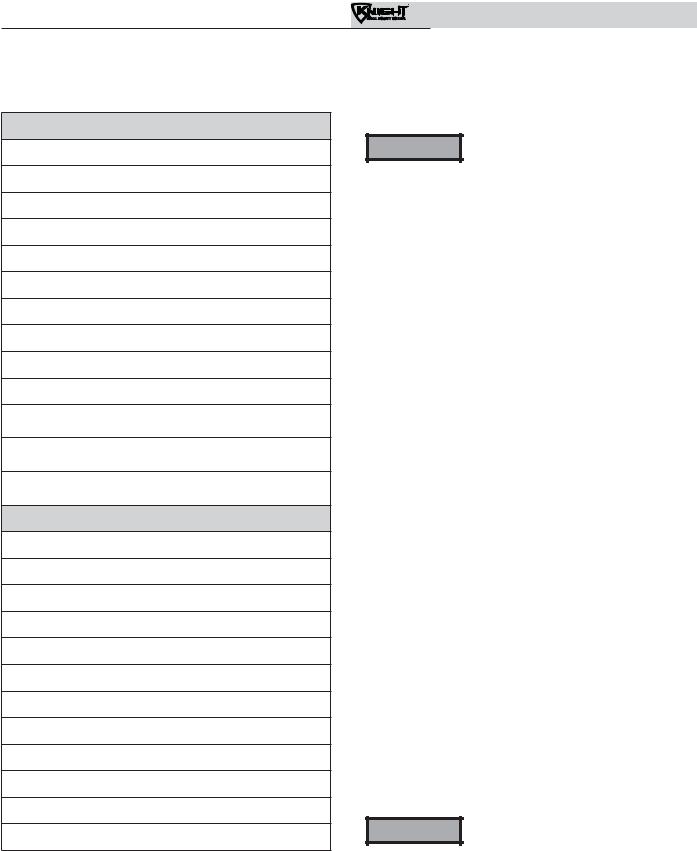
1 Determine boiler location
Table 1A Corrosive Contaminants and Sources
Products to avoid:
Spray cans containing chloro/fluorocarbons
Permanent wave solutions
Chlorinated waxes/cleaners
Chlorine-based swimming pool chemicals
Calcium chloride used for thawing
Sodium chloride used for water softening
Refrigerant leaks
Paint or varnish removers
Hydrochloric acid/muriatic acid
Cements and glues
Antistatic fabric softeners used in clothes dryers
Chlorine-type bleaches, detergents, and cleaning solvents found in household laundry rooms
Adhesives used to fasten building products and other similar products
Areas likely to have contaminants
Dry cleaning/laundry areas and establishments
Swimming pools
Metal fabrication plants
Beauty shops
Refrigeration repair shops
Photo processing plants
Auto body shops
Plastic manufacturing plants
Furniture refinishing areas and establishments
New building construction
Remodeling areas
Garages with workshops
Installation & Operation Manual
When using an existing vent system to install a new boiler:
WARNING Failure to follow all instructions can result in flue gas spillage and carbon monoxide
emissions, causing severe personal injury or death.
Check the following venting components before installing:
•Material - For materials listed for use with this appliance, see Section 3 - General Venting. For polypropylene or stainless steel venting, an adapter of the same manufacturer must be used at the flue collar connection.
•Size - To ensure proper pipe size is in place, see Table 3A. Check to see that this size is used throughout the vent system.
•Manufacturer - For a stainless steel or polypropylene application, you must use only the listed manufacturers and their type product listed in Tables 3E and 3G for CAT IV positive pressure venting with flue producing condensate.
•Supports - Non-combustible supports must be in place allowing a minimum 1/4" rise per foot. The supports should adequately prevent sagging and vertical slippage, by distributing the vent system weight. For additional information, consult the vent manufacturer’s instructions for installation.
•Terminations - Carefully review Sections 3 through 5 to ensure requirements for the location of the vent and air terminations are met and orientation of these fit the appropriate image from the Sidewall or Vertical options listed in the General Venting Section. For stainless steel vent, only use terminations listed in Table 3H for the manufacturer of the installed vent.
•Seal - With prior requirements met, the system should be tested to the procedure listed in parts (c) through (f) of the Removal of an Existing Boiler Section on page 11.
With polypropylene and stainless steel vent, seal and connect all pipe and components as specified by the vent manufacturer used; with PVC/CPVC vent, see the Installing Vent or Air Piping Section on page 19.
If any of these conditions are not met,WARNING the existing system must be updated or
replaced for that concern. Failure to follow all instructions can result in flue gas spillage and carbon monoxide emissions, causing severe personal injury or death.
 10
10 

Installation & Operation Manual
1 Determine boiler location (continued)
When removing a boiler from existing common vent system:
DANGER |
Do not install the Knight wall mount |
|
boiler into a common vent with any other |
||
|
||
|
appliance. This will cause flue gas spillage or |
|
|
appliance malfunction, resulting in possible |
|
|
severe personal injury, death, or substantial |
|
|
property damage. |
|
|
Failure to follow all instructions can result |
|
WARNING |
||
in flue gas spillage and carbon monoxide |
||
|
emissions, causing severe personal injury or |
|
|
death. |
At the time of removal of an existing boiler, the following steps shall be followed with each appliance remaining connected to the common venting system placed in operation, while the other appliances remaining connected to the common venting system are not in operation.
a.Seal any unused openings in the common venting system.
b.Visually inspect the venting system for proper size and horizontal pitch and determine there is no blockage or restriction, leakage, corrosion, or other deficiencies, which could cause an unsafe condition.
c.Test vent system – Insofar as is practical, close all building doors and windows and all doors between the space in which the appliances remaining connected to the common venting system are located and other spaces of the building. Turn on clothes dryers and any appliance not connected to the common venting system. Turn on any exhaust fans, such as range hoods and bathroom exhausts, so they will operate at maximum speed. Do not operate a summer exhaust fan. Close fireplace dampers.
d.Place in operation the appliance being inspected. Follow the lighting instructions. Adjust thermostat so appliance will operate continuously.
e. Test for spillage at the draft hood relief opening after 5 minutes of main burner operation. Use the flame of a match or candle, or smoke from a cigarette, cigar, or pipe.
f.After it has been determined that each appliance remaining connected to the common venting system properly vents when tested as outlined herein, return doors, windows, exhaust fans, fireplace dampers, and any other gas-burning appliance to their previous conditions of use.
g.Any improper operation of the common venting system should be corrected so the installation conforms with the National Fuel Gas Code, ANSI Z223.1/NFPA 54 and/or CAN/CSA B149.1, Natural Gas and Propane Installation Code. When resizing any portion of the common venting system, the common venting system should be resized to approach the minimum size as determined using the appropriate tables in Part 11 of the National Fuel Gas Code, ANSI Z223.1/NFPA and/or CAN/CSA B149.1, Natural Gas and Propane Installation Code.
 11
11 
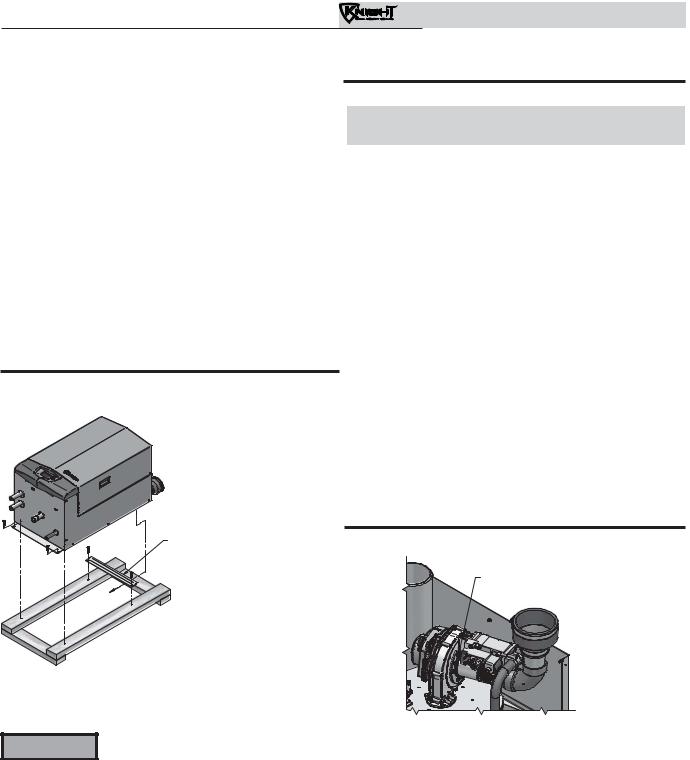
2 Prepare boiler
Remove boiler from wood pallet
1.After removing the outer shipping carton from the boiler, remove the parts box.
2.To remove the boiler from the pallet:
a.Remove the two (2) lag bolts securing the bottom of the unit to the pallet.
b.Lift the boiler off the wall bracket mounted to the pallet.
3.Remove the two (2) lag bolts securing the wall bracket to the wood pallet. Be certain not to lose the wall bracket as it will be needed for securing the boiler to the wall (FIG. 2-1).
NOTICE |
Do not drop the boiler or bump the jacket |
on the floor or pallet. Damage to the |
|
|
boiler can result. |
Figure 2-1 Boiler Mounted on Shipping Pallet
REMOVE SHIPPING [WALL] BRACKET DO NOT DISCARDWILL BE NEEDED TO
SECURE THE BOILER TO THE WALL
Gas conversions
WARNING
 12
12 
The gas conversion procedure should be accomplished BEFORE the boiler is installed. For a boiler already installed, you must turn off gas supply, turn off power, and allow the boiler to cool before proceeding. You must also completely test the boiler after conversion to verify performance as described under Start-up, Section 10 of this manual.
You must install the propane orifice to fire the Knight wall mount boiler on propane. Verify when installing that the orifice size marking matches boiler size (Table 2A). Failure to comply could result in severe personal injury, death, or substantial property damage.
Installation & Operation Manual
Table 2A LP Conversion Table
|
LP Conversion Table |
|
Model |
|
LP Orifice Stamping |
55 |
|
055 |
85 |
|
085 |
110 |
|
110 |
155 |
|
155 |
199 |
|
199 |
285 |
|
H285 |
399 |
|
8.0 |
1.Remove the front access cover from the unit (no tools required for removal).
2.Models 55 - 285 only, locate the power switch on the gas valve and turn the power switch to the “OFF” position (FIG. 2-2).
3.Model 399 only, shut off power at the source.
4.Disconnect the Molex plug from the gas valve.
5.Using a 5/16" nut driver, loosen the band clamp securing the air intake coupler to the gas valve venturi. Remove the air intake pipe and coupler from the gas valve venturi.
6.Using an Allen wrench, remove the screws securing the gas valve venturi to the inlet of the combustion blower (FIG. 2-2).
Figure 2-2 Gas Valve Power Switch & Venturi Removal
REMOVE THE SCREWS SECURING
THE GAS VALVE VENTURI TO THE
INLET OF THE COMBUSTION
BLOWER
7.Using an Allen wrench, remove the screws securing the gas pipe to the gas valve. Remove the gas valve venturi assembly from the unit (FIG. 2-3).
8.Using an Allen wrench, remove the venturi from the gas valve.
9.Locate the propane orifice disk from the conversion kit bag. Verify that the stamping on the orifice disk matches the boiler size (see Table 2A).
10.Place the orifice into the black rubber grommet in the side of the gas valve and secure inside the gas valve (see FIG. 2-3).
11.Reattach the venturi to the gas valve and reposition the gas valve venturi assembly inside the unit. Secure the venturi back to the gas valve (FIG. 2-3).
12.Reattach the gas pipe to the gas valve. Reattach the air intake and coupler and tighten down on the band clamp.

2 Prepare boiler (continued)
13.Reattach the Molex plug to the gas valve.
14.Models 55 - 285 only, turn the gas valve power switch to the “ON” position.
15.Model 399 only, turn on power at the source.
16.After the installation is complete, fill out the gas conversion label (in the conversion kit bag) and affix it to the unit under the boiler rating plate inside the unit. Attach the LP caution label (in the conversion kit bag) to the left side of the unit in the lower left corner.
17.Replace the front access cover.
WARNING |
After converting to LP, check combustion |
per the Start-up procedure in Section 10 |
of this manual. Failure to check and verify combustion could result in severe personal injury, death, or substantial property damage.
Figure 2-3 Installing Propane Orifice
GAS VALVE
GROMMET
BRASS ORIFICE
SCREWS
VENTURI
Mounting the boiler
See page 9 of this manual for boiler mounting location instructions.
NOTICE |
The Knight Wall Mount boiler is not |
|
intended for floor installation. |
||
|
Mounting to a wood studded wall:
1.The wall mount bracket is designed for a stud spacing of 16 inches from center. For other stud spacing a solid mounting surface must be provided by the installer.
WARNING Do not mount the boiler to a hollow wall.
Be sure to mount the boiler to the studs only.
2.Mount the wall bracket using the 2 1/4" lag bolts provided. Make sure the top edge of the bracket is away from the wall. Ensure the bracket is level when mounted. Extreme care is needed to ensure the bolts are secured in the center of the studs.
3.Hang the boiler on the bracket and secure the bottom of the boiler with two (2) additional lag bolts provided.
Installation & Operation Manual
WARNING The boiler is too heavy for a single person to lift. A minimum of two people is needed for
mounting the boiler onto the bracket.
Mounting to a concrete wall:
1.Mount the wall bracket using the two (2) wedge anchor bolts provided with the bracket. To mount the wedge anchor bolts, drill a 1/4" diameter hole 1 1/8" deep and insert anchor. Hang the bracket from the anchor and secure with the two nuts provided. Make sure the top edge of the bracket is away from the wall. Ensure bracket is level when mounted. Extreme care is needed to ensure the bolts are secured in the center of the studs.
Note: If wall thickness does not allow a 1 1/8" deep hole, field supplied hardware suitable for the application should be provided.
2.Hang the boiler on the bracket and secure the bottom of the boiler with two (2) remaining anchors, following the instructions above.
The boiler is too heavy for a single person toWARNING lift. A minimum of two people is needed for
mounting the boiler onto the bracket.
Mounting to a metal studded wall:
1. The wall mount bracket is designed for a stud spacing of 16 inches from center. For other stud spacing a solid mounting surface must be provided by the installer.
WARNING Do not mount the boiler to a hollow wall. Be sure to mount the boiler to the studs only.
2.Mount the wall bracket using two (2) field supplied toggle bolts capable of supporting 100 pounds each. Ensure the top edge of the bracket is away from the wall. Ensure the bracket is level when mounted. Extreme care is needed to ensure the bolts are secured in the center of the studs.
3.Hang the boiler on the bracket and secure the bottom of the boiler with two (2) field supplied toggle bolts.
WARNING The boiler is too heavy for a single person to lift. A minimum of two people is needed
for mounting the boiler onto the bracket.
Figure 2-4 Mounting the Boiler
WALL:
WOOD OR METAL STUDS ON 16" CENTERS -OR-
MASONRY / POURED CONCRETE MOUNTING BRACKET (FACTORY SUPPLIED)
FASTENERS APPROPRIATE FOR WALL TYPE
QTY: 4
13
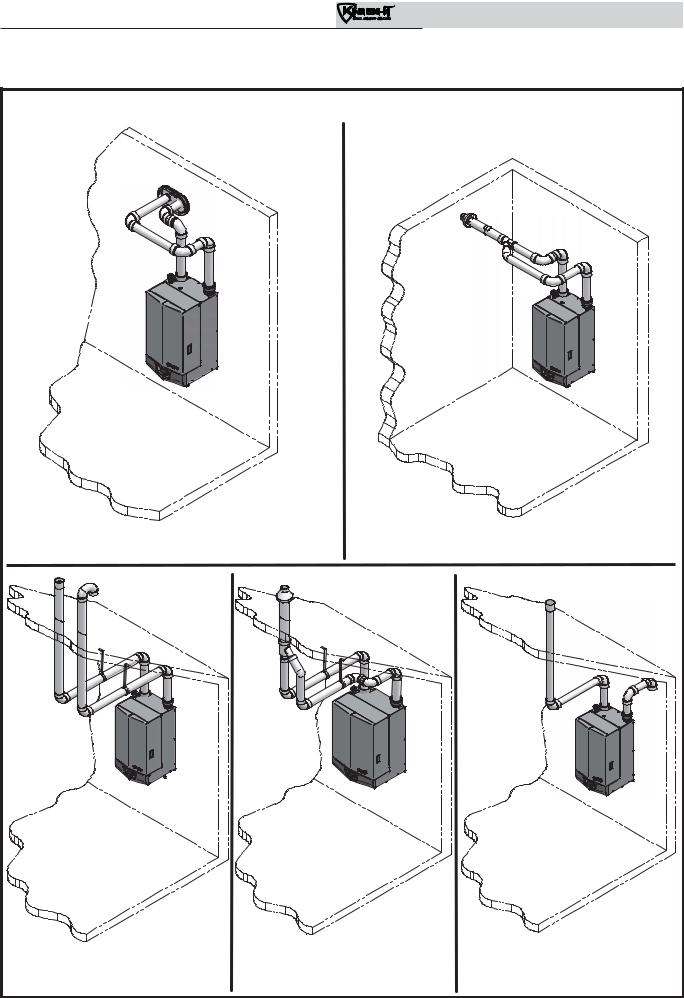
Installation & Operation Manual
3 General venting
Direct venting options - Sidewall Vent
Figure 3-1 Two-Pipe Sidewall Termination - See page 22 for more details
Figure 3-2 PVC/CPVC Concentric Sidewall Termination - See page 26 for more details
Figure 3-3 Two-Pipe Vertical Termination - See page 29 for more details
Figure 3-4 PVC/CPVC Concentric Vertical Termination - See page 30 for more details
Figure 3-5 Vertical Vent, Sidewall Air - See page 18 for more details
 14
14 
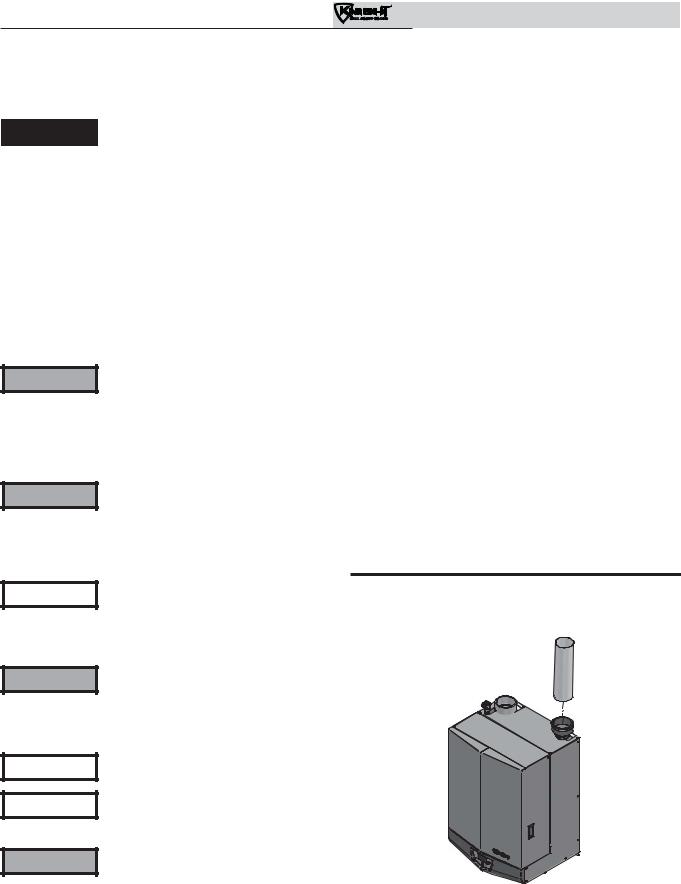
Installation & Operation Manual
3 General venting
Install vent and combustion air piping
DANGER The Knight wall mount boiler must be vented and supplied with combustion and
ventilation air as described in this section. Ensure the vent and air piping and the combustion air supply comply with these instructions regarding vent system, air system, and combustion air quality. See also Section 1 of this manual.
Inspect finished vent and air piping thoroughly to ensure all are airtight and comply with the instructions provided and with all requirements of applicable codes.
Failure to provide a properly installed vent and air system will cause severe personal injury or death.
WARNING
WARNING
NOTICE
This appliance requires a special venting system. Use only approved stainless steel, PVC, CPVC or polypropylene pipe and fittings listed in Tables 3D, 3E, and 3G for vent pipe, and fittings. Failure to comply could result in severe personal injury, death, or substantial property damage.
DO NOT mix components from different systems. The vent system could fail, causing leakage of flue products into the living space. Mixing of venting materials will void the warranty and certification of the appliance.
Installation must comply with local requirements and with the National Fuel Gas Code, ANSI Z223.1 for U.S. installations or CSA B149.1 for Canadian installations.
WARNING
CAUTION NOTICE
For closet and alcove installations, CPVC, polypropylene or stainless steel material MUST BE used in a closet/alcove structure. Failure to follow this warning could result in fire, personal injury, or death.
Improper installation of venting systems may result in injury or death.
Follow the instructions in Section 1, page 11 of this manual when removing a boiler from an existing vent system.
WARNING Do not connect any other appliance to the vent pipe or multiple boilers to a
common vent pipe. Failure to comply could result in severe personal injury, death, or substantial property damage.
The Knight wall mount boiler vent and air piping can be installed through the roof or through a sidewall. Follow the procedures in this manual for the method chosen. Refer to the information in this manual to determine acceptable vent and air piping length.
You may use any of the vent/air piping methods covered in this manual. Do not attempt to install the Knight wall mount boiler using any other means.
You must also install air piping from outside to the boiler air intake adapter unless following the Optional Room Air instructions on page 18 of this manual. The resultant installation is direct vent (sealed combustion).
Air intake/vent connections
1.Combustion Air Intake Connector (FIG. 3-6) - Used to provide combustion air directly to the unit from outdoors. A fitting is provided on the unit for final connection. Combustion air piping must be supported per guidelines listed in the National Mechanical Code, Section 305, Table 305.4 or as local codes dictate.
2.Vent Connector (FIG.'s 3-7 thru 3-9) - Used to provide a passageway for conveying combustion gases to the outside. A transition fitting is provided on the unit for final connection. Vent piping must be supported per the National Building Code, Section 305, Table 305.4 or as local codes dictate.
Figure 3-6 Near Boiler Air Piping
AIR
 15
15 
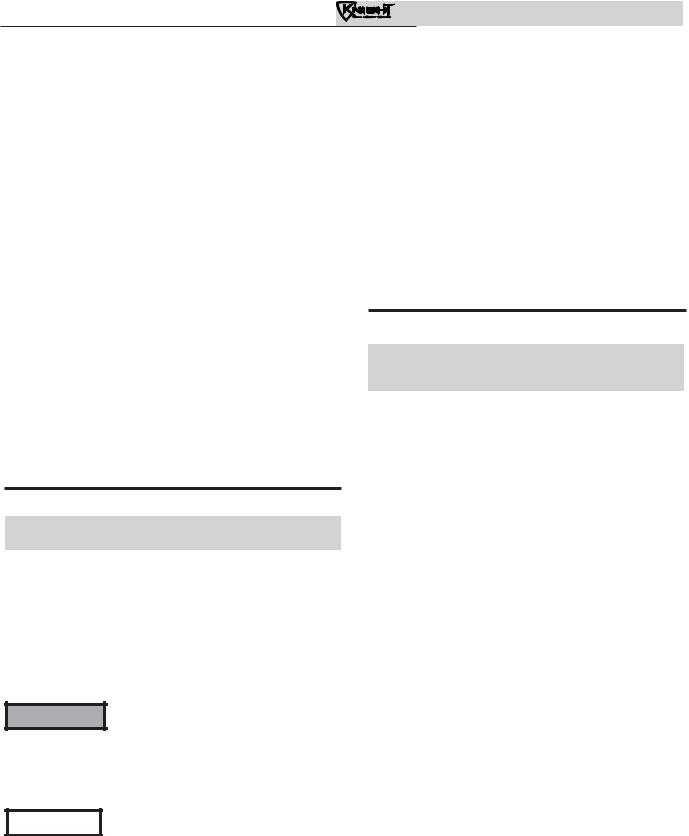
3 General venting
Requirements for installation in Canada
1.Installations must be made with a vent pipe system certified to ULC-S636.
2.The first three (3) feet of plastic vent pipe from the appliance flue outlet must be readily accessible for visual inspection.
3.The components of the certified vent system must not be interchanged with other vent systems or unlisted pipe/fittings. For concentric vent installations, the inner vent tube must be replaced with field supplied certifiedvent material to comply with this requirement.
4.The 2" and 3" Concentric Vent Kits available from Lochinvar (see Section 4 – Sidewall Termination – Optional Concentric Vent) and the 2" and 3" Concentric Vent Kits available from IPEX are approved for use on the Knight wall mount boiler. Both kits are listed to the ULC-S636 standard for use in Canada.
Sizing
The Knight boiler uses model specific combustion air intake and vent piping sizes as detailed in Table 3A below.
Table 3A Air Intake/Vent Piping Sizes
Model |
2" Max Vent/ |
3" Max Vent/ |
4" Max Vent/ |
|
Air |
Air |
Air |
||
|
||||
55 |
*80 feet |
100 feet |
N/A |
|
85 |
*50 feet |
100 feet |
N/A |
|
110 |
*40 feet |
100 feet |
N/A |
|
155 |
N/A |
100 feet |
N/A |
|
199 |
N/A |
100 feet |
N/A |
|
285 |
N/A |
*50 feet |
100 feet |
|
399 |
N/A |
N/A |
100 feet |
* WARNING
NOTICE
For Models 55, 85, and 110 using 2" venting and Model 285 using 3" venting, the first seven (7) equivalent feet of vent must be CPVC (field supplied). This includes any transition piece used to increase or decrease the vent diameter.
Increasing or decreasing combustion air or vent piping sizes is not authorized.
Installation & Operation Manual
Note: The minimum combustion air and vent piping length is 12 equivalent feet.
When determining equivalent combustion air and vent length, add 5 feet for each 90° elbow and 3 feet for each 45° elbow.
EXAMPLE: 20 feet of PVC pipe + (4) 90° elbows + (2) 45° elbows + (1) concentric vent kit (CVK3003) = 49 equivalent feet of piping.
NOTICE |
The appliance output rating will reduce |
|
by up to 1.5% for each 25 feet of vent |
||
|
||
|
length. |
Table 3B Concentric Vent Kit Equivalent Vent Lengths
Model |
Kit Number |
Equivalent Vent |
|
Length |
|||
|
|
||
55 - 110 |
CVK3008 |
3 feet |
|
|
|
|
|
155 - 199 |
CVK3003 |
3 feet |
|
|
|
|
|
285 - 399 |
CVK3007 |
3 feet |
|
|
|
|
 16
16 
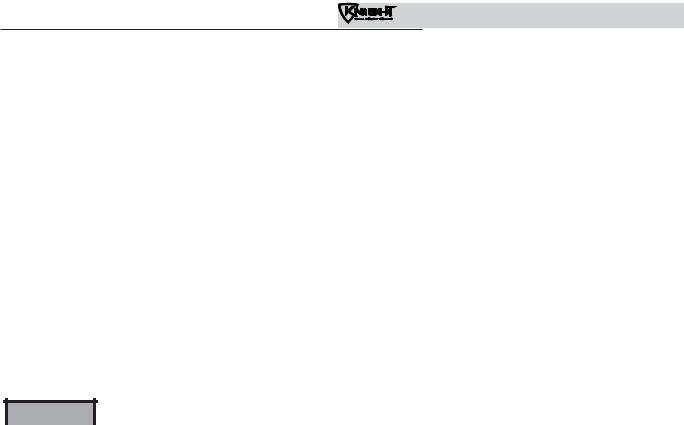
3 General venting (continued)
Materials
Air inlet pipe materials:
The air inlet pipe(s) must be sealed. Choose acceptable combustion air inlet pipe materials from the following list:
PVC, CPVC, Polypropylene or ABS
Dryer Vent or Sealed Flexible Duct (not recommended for rooftop air inlet)
Galvanized steel vent pipe with joints and seams sealed as specified in this section.
Type “B” double-wall vent with joints and seams sealed as specified in this section.
AL29-4C, stainless steel material to be sealed to specification of its manufacturer.
*Plastic pipe may require an adapter (not provided) to transition between the air inlet connection on the appliance and the plastic air inlet pipe.
WARNING Using air intake materials other than
|
those specified can result in personal |
|
|
|
injury, death or property damage. |
|
The use of double-wall vent or insulated |
NOTICE |
|
|
material for the combustion air inlet pipe is |
|
|
|
recommended in cold climates to prevent |
|
the condensation of airborne moisture in |
|
the incoming combustion air. |
Sealing of Type “B” double-wall vent material or galvanized vent pipe material used for air inlet piping on a sidewall or vertical rooftop Combustion Air Supply System:
a.Seal all joints and seams of the air inlet pipe using either Aluminum Foil Duct Tape meeting UL Standard 723 or 181A-P or a high quality UL Listed silicone sealant such as those manufactured by Dow Corning or General Electric.
b.Do not install seams of vent pipe on the bottom of horizontal runs.
c.Secure all joints with a minimum of three (3) sheet metal screws or pop rivets. Apply Aluminum Foil Duct Tape or silicone sealant to all screws or rivets installed in the vent pipe.
d.Ensure that the air inlet pipes are properly supported.
Installation & Operation Manual
The PVC, CPVC, or ABS air inlet pipe should be cleaned and sealed with the pipe manufacturer’s recommended solvents and standard commercial pipe cement for the material used. The PVC, CPVC, ABS, Dryer Vent or Flex Duct air inlet pipe should use a silicone sealant to ensure a proper seal at the appliance connection and the air inlet cap connection. Dryer vent or flex duct should use a screw type clamp to seal the vent to the appliance air inlet and the air inlet cap. Proper sealing of the air inlet pipe ensures that combustion air will be free of contaminants and supplied in proper volume.
When a sidewall or vertical rooftop combustion air supply system is disconnected for any reason, the air inlet pipe must be resealed to ensure that combustion air will be free of contaminants and supplied in proper volume.
DANGER |
Failure to properly seal all joints and seams |
as required in the air inlet piping may |
|
|
result in flue gas recirculation, spillage |
|
of flue products and carbon monoxide |
|
emissions causing severe personal injury |
|
or death. |
 17
17 
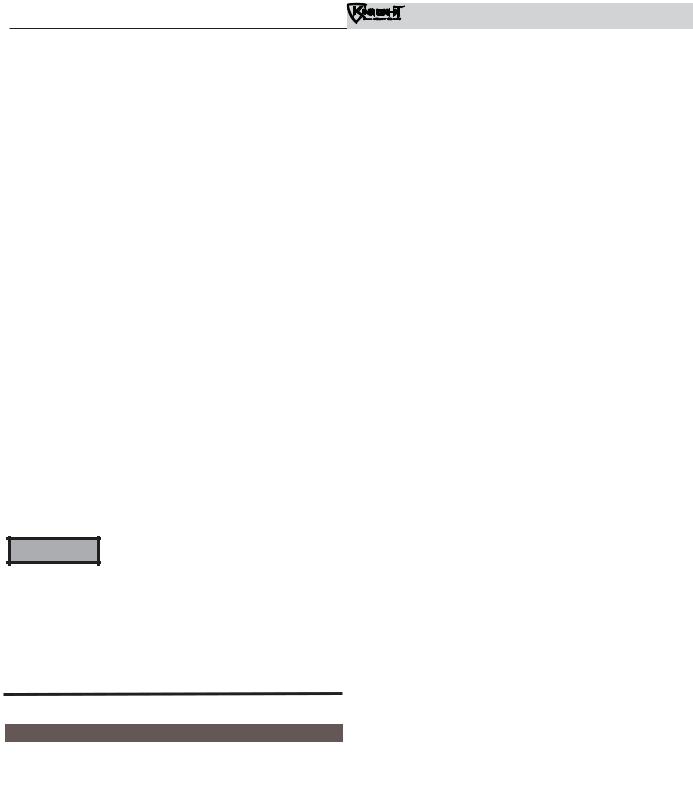
3 General venting
Optional room air
NOTICE |
Optional room air is intended for |
|
commercial applications. Combustion air |
||
|
||
|
piping to the outside is recommended for |
|
|
residential applications. |
Commercial applications utilizing the Knight wall mount boiler may be installed with a single pipe carrying the flue products to the outside while using combustion air from the equipment room. In order to use the room air venting option the following conditions and considerations must be followed.
• The unit MUST be installed with the appropriate room air kit (Table 3C).
• The equipment room MUST be provided with properly sized openings to assure adequate combustion air. Please refer to instructions provided with the room air kit.
• There will be a noticeable increase in the noise level during normal operation from the inlet air opening.
• Using the room air kit makes the unit vulnerable to combustion air contamination from within the building. Please review Section 1, Prevent Combustion Air Contamination, to ensure proper installation.
• Vent system and terminations must comply with the standard venting instructions set forth in this manual.
WARNING When utilizing the single pipe method, provisions for combustion and ventilation
air must be in accordance with Air for Combustion and Ventilation, of the latest edition of the National Fuel Gas Code, ANSI Z223.1, in Canada, the latest edition of CGA Standard B149 Installation Code for Gas Burning Appliances and Equipment, or applicable provisions of the local building codes.
Table 3C |
Optional Room Air Kit |
|
||
|
|
|
|
|
|
Model |
Vent Size |
Kit Number |
|
|
55 - 110 |
2" |
KIT30051 |
|
|
55 - 285 |
3" |
KIT30052 |
|
|
199 - |
399 |
4" |
KIT30053 |
Installation & Operation Manual
Air contamination
Pool and laundry products and common household and hobby products often contain fluorine or chlorine compounds. When these chemicals pass through the boiler, they can form strong acids. The acid can eat through the boiler wall, causing serious damage and presenting a possible threat of flue gas spillage or boiler water leakage into the building.
Please read the information given in Table 1A, page 10, listing contaminants and areas likely to contain them. If contaminating chemicals will be present near the location of the boiler combustion air inlet, have your installer pipe the boiler combustion air and vent to another location, per this manual.
WARNING |
If the boiler combustion air inlet is located |
|
in a laundry room or pool facility, for |
|
example, these areas will always contain |
|
hazardous contaminants. |
|
To prevent the potential of severe personal |
WARNING |
|
|
injury or death, check for areas and |
|
products listed in Table 1A, page 10 before |
|
installing the boiler or air inlet piping. |
|
If contaminants are found, you MUST: |
|
• Remove contaminants permanently. |
|
—OR— |
|
• Relocate air inlet and vent |
|
terminations to other areas. |
 18
18 
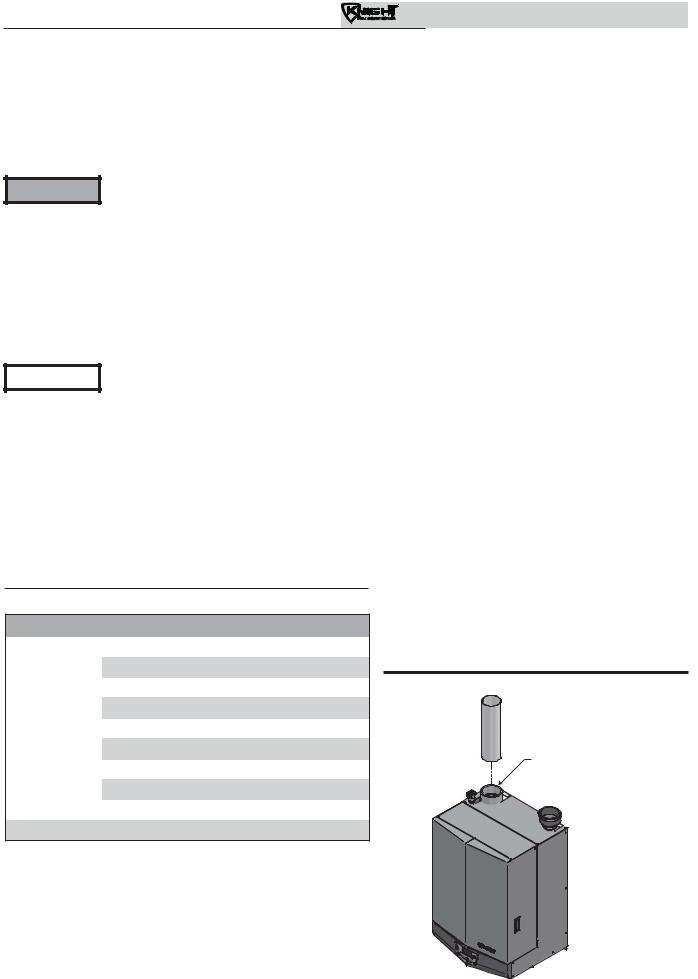
Installation & Operation Manual
3 General venting (continued)
PVC/CPVC
This product has been approved for use with the PVC/CPVC vent materials listed in Table 3D.
Installing vent and air piping
WARNING
NOTICE
The vent connection to the appliance must be made with the starter piece provided with the appliance if PVC/CPVC vent is to be used. The field provided vent fittings must be cemented to the CPVC pipe section using an “All Purpose Cement” suitable for PVC and CPVC pipe. Use only the vent materials, primer, and cement specified in Table 3D to make the vent connections. Failure to follow this warning could result in fire, personal injury, or death.
Use only cleaners, primers, and solvents that are approved for the materials which are joined together.
NOTICE |
All PVC vent pipes must be glued, properly |
supported, and the exhaust must be |
|
|
pitched a minimum of a 1/4 inch per foot |
|
back to the boiler (to allow drainage of |
|
condensate). |
WARNING |
Insulation should not be used on PVC |
|
or CPVC venting materials. The use of |
|
insulation will cause increased vent wall |
|
temperatures, which could result in vent |
|
pipe failure. |
Table 3D PVC/CPVC Vent Pipe, and Fittings
Approved PVC/CPVC Vent Pipe and Fittings
Item |
Material |
Standard |
|
PVC Schedule 40, 80 |
ANSI/ASTM D1785 |
Vent pipe |
PVC - DWV |
ANSI/ASTM D2665 |
|
CPVC Schedule 40, 80 |
ANSI/ASTM F441 |
|
PVC Schedule 40 |
ANSI/ASTM D2466 |
Vent fittings |
PVC Schedule 80 |
ANSI/ASTM D2467 |
|
CPVC Schedule 80 |
ANSI/ASTM F439 |
Pipe Cement / |
PVC |
ANSI/ASTM D2564 |
Primer |
CPVC |
ANSI/ASTM F493 |
NOTICE: DO NOT USE CELLULAR (FOAM) CORE PIPE
1.Work from the boiler to vent or air termination. Do not exceed the lengths given in this manual for the air or vent piping.
2.Cut pipe to the required lengths and deburr the inside and outside of the pipe ends.
3.Chamfer outside of each pipe end to ensure even cement distribution when joining.
4.Clean all pipe ends and fittings using a clean dry rag. (Moisturewillretardcuringanddirtorgreasewillprevent adhesion.)
5.Dry fit vent or air piping to ensure proper fit up before assembling any joint. The pipe should go a third to two-thirds into the fitting to ensure proper sealing after cement is applied.
6.Priming and Cementing:
a.Handle fittings and pipes carefully to prevent contamination of surfaces.
b.Apply a liberal even coat of primer to the fitting socket and to the pipe end to approximately 1/2" beyond the socket depth.
c.Apply a second primer coat to the fitting socket.
d.While primer is still wet, apply an even coat of approved cement to the pipe equal to the depth of the fitting socket along with an even coat of approved cement to the fitting socket.
e.Apply a second coat of cement to the pipe.
f.While the cement is still wet, insert the pipe into the fitting, if possible twist the pipe a 1/4 turn as you insert it. NOTE: If voids are present, sufficient cement was not applied and joint could be defective.
g.Wipe excess cement from the joint removing ring or beads as it will needlessly soften the pipe.
Figure 3-7 Near Boiler PVC/CPVC Venting
CPVC STARTER PIECE
NOTE: In Canada, CPVC and PVC vent pipe, fittings and cement/ primer must be ULC-S636 certified.
 19
19 
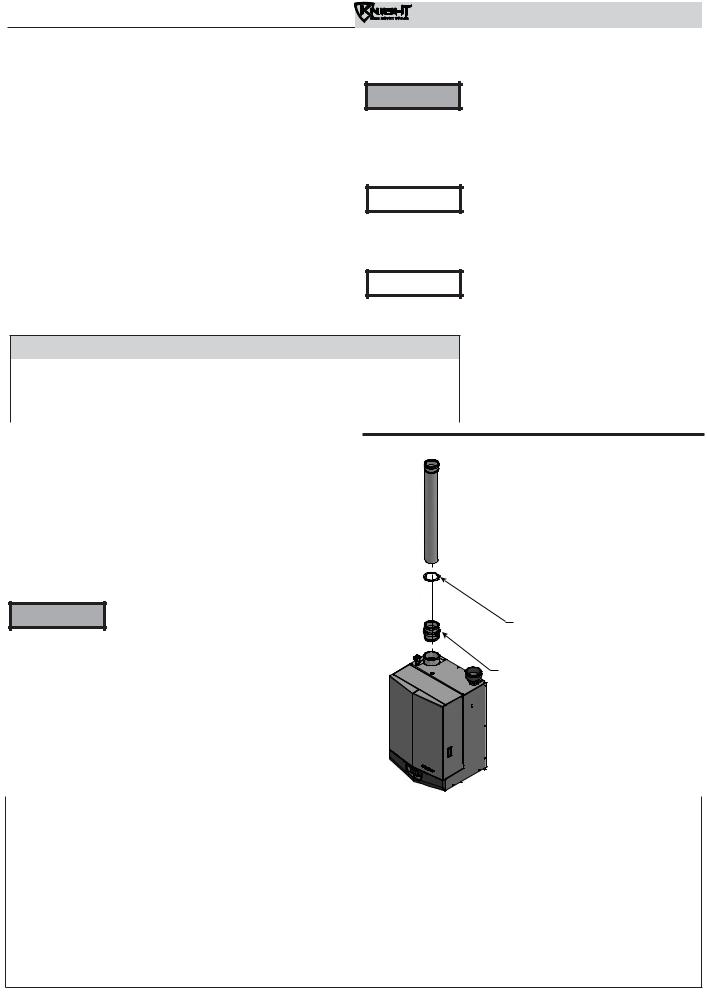
3 General venting
Polypropylene
This product has been approved for use with polypropylene vent with the manufacturers listed in Table 3E.
All terminations must comply with listed options in this manual and be a single-wall vent offering.
For use of flex pipe, it is recommended to have the vent material in 32°F or higher ambient space before bending at installation. No bends should be made to greater than 45° and ONLY installed in vertical or near vertical installations.
For support and special connections required, see the manufacturer's instructions. All vent is to conform to standard diameter and equivalent length requirements established.
WARNING
NOTICE
NOTICE
Table 3E Polypropylene Vent Pipe and Fittings
Approved Polypropylene Vent Manufacturers
Make |
Model |
Centrotherm Eco Systems |
InnoFlue SW/Flex |
|
|
Duravent (M & G Group) |
PolyPro Single-Wall / PolyPro Flex |
|
|
Installation & Operation Manual
Use only the adapters and vent system listed in Tables 3E and 3F. DO NOT mix vent systems of different types or manufacturers. Failure to comply could result in severe personal injury, death, or substantial property damage.
Installations must comply with applicable national, state, and local codes. For Canadian installation, polypropylene vent must be listed as a ULC-S636 approved system.
Installation of a polypropylene vent system should adhere to the vent manufacturer’s installation instructions supplied with the vent system.
NOTICE |
The installer must use a specific vent starter |
|
adapter at the flue collar connection. |
||
|
The adapter is supplied by the vent |
|
|
manufacturer to adapt to its vent system. |
|
|
See Table 3F for approved vent adapters. |
|
|
All vent connections MUST be secured by |
|
NOTICE |
||
the vent manufacturer's joint connector |
||
|
(FIG. 3-8). |
WARNING Insulation should not be used on polypropylene venting materials. The use
of insulation will cause increased vent wall temperatures, which could result in vent pipe failure.
Table 3F Approved PolypropyleneTerminations
Figure 3-8 Near Boiler Polypropylene Venting
JOINT CONNECTOR REQUIRED
AT ALL COMPONENT CONNECTIONS
OF VENT SYSTEM
POLYPROPYLENE ADAPTER
W/FLUE CLAMP
IMG00130
|
|
Centrotherm InnoFlue SW |
Duravent Polypro |
|
||||
|
|
|
|
|
|
|
|
|
Model |
Polypropylene |
|
Joint |
Sidewall |
|
|
Joint |
|
|
Adapter |
|
Connector |
Retaining |
Sidewall Adapter* |
Polypropylene Adapter |
Connector |
Sidewall Kit* |
|
|
|
|
Bracket* |
|
|
|
|
55 - 85 |
ISAG0202 w/ |
|
IANS02 |
IATP0202 |
ISTAGL0202 |
2PPS-AD w/PPS-PAC |
2PPS-LB |
2PPS-HLK |
IAFC02 |
|
|||||||
|
|
|
|
|
|
|
|
|
110 - 285 |
ISAG0303 w/ |
|
IANS03 |
IATP0303 |
ISTAGL0303 |
3PPS-AD w/PPS-PAC |
3PPS-LB |
3PPS-HLK |
IAFC03 |
|
|||||||
|
|
|
|
|
|
|
|
|
399 |
ISAG0404 w/ |
|
IANS04 |
IATP0404 |
ISTAGL0404 |
4PPS-AD w/PPS-PAC |
4PPS-LB |
4PPS-HLK |
IAFC04 |
|
|||||||
|
|
|
|
|
|
|
|
|
* These parts are only needed if the sidewall termination assembly is used (see FIG. 4-4B on page 24).
 20
20 
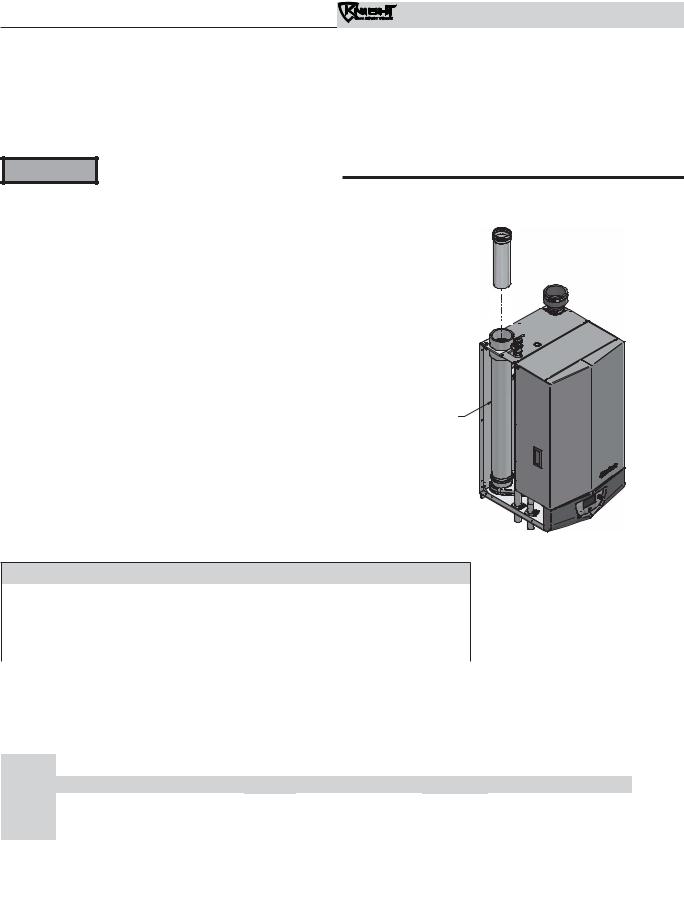
3 General venting (continued)
Stainless steel vent
This product has been approved for use with stainless steel using the manufacturers listed in Table 3G.
WARNING Use only the materials, vent systems, and terminations listed in Tables 3G and 3H.
DO NOT mix vent systems of different types or manufacturers. Failure to comply could result in severe personal injury, death, or substantial property damage.
NOTICE |
The installer must use a specific vent starter |
|
adapter at the flue collar connection, |
||
|
supplied by the vent manufacturer to |
|
|
adapt to its vent system. See Table 3H for |
|
|
approved vent adapters. Discard CPVC |
|
|
starter piece. |
|
|
Installations must comply with applicable |
|
NOTICE |
||
national, state, and local codes. Stainless |
||
|
steel vent systems must be listed as a |
|
|
UL-1738 approved system for the United |
|
|
States and a ULC-S636 approved system |
|
|
for Canada. |
Installation & Operation Manual
NOTICE |
Installation of a stainless steel vent |
system should adhere to the stainless |
|
|
steel vent manufacturer’s installation |
|
instructions supplied with the vent |
|
system. |
Figure 3-9 Near Boiler Stainless Steel Venting
VENT
REPLACE APPLIANCE
SECURED CPVC ADAPTER
WITH APPROPRIATE
STAINLESS STEEL ADAPTER
FROM TABLE 3H
Table 3G Stainless Steel Vent Pipe and Fittings
Approved Stainless Steel Vent Manufacturers
Make |
Model |
Dura Vent (M & G Group) |
FasNSeal Vent / FasNSeal Flex* Vent |
Z-Flex (Nova Flex Group) |
Z-Vent |
|
|
Heat Fab (Selkirk Corporation) |
Saf-T Vent |
*Use of FasNSeal Flex smooth inner wall vent is to be used in vertical or near vertical sections only, taking precaution to ensure no sagging occurs of the vent system. Connect to the FasNSeal rigid vent using specially designed adapters and sealing method, see manufacturer’s instructions.
Table 3H Approved Stainless Steel (S.S.) Terminations and Adapters
|
|
ProTech |
|
Heat Fab |
|
Z Flex |
|
|||
Model |
|
FasNSeal |
|
|
Saf-T Vent |
|
Z-Vent |
|
||
Boiler |
Flue |
Intake |
Boiler |
|
Flue |
Intake |
Boiler |
Flue |
Intake Air |
|
|
Adapter |
Termination |
Air |
Adapter |
|
Termination |
Air |
Adapter |
Termination |
Termination |
|
Termination |
|
Termination |
|||||||
55 - 85 |
303005 |
FSBS3 |
303889 |
WH0002 |
|
9392 |
9314TERM |
2SVAKA02 |
2SVSTP03 |
2SVSTEX0390 |
|
|
FSRC3(R.C) |
|
|
5300CI |
|
2SVSRCX03 |
|||
110 -285 |
303006 |
WH0003 |
|
2SVAKA03 |
||||||
|
|
|
|
|||||||
|
|
|
|
|
|
|
||||
|
|
|
|
|
|
|
|
|
|
|
399 |
303007 |
FSBS4 |
FSAIH04 |
WH0004 |
|
9492 |
9414TERM |
2SVAKA04 |
2SVSTP04 |
2SVSTEX0490 |
FSRC4(R.C) |
303888 |
|
5400CI |
2SVSRCX04 |
||||||
 21
21 
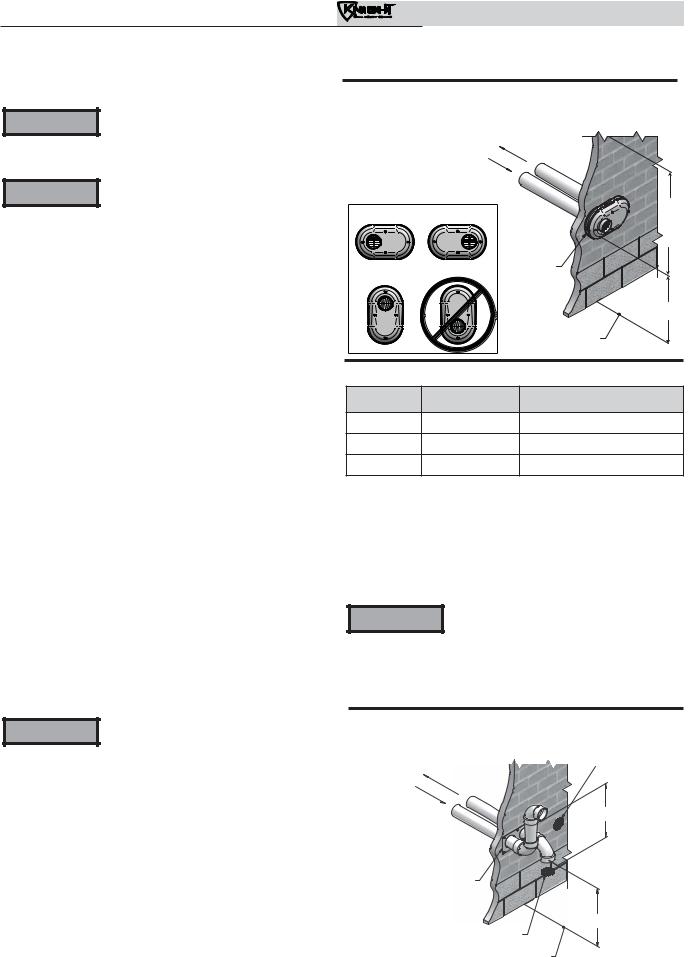
Installation & Operation Manual
4 Sidewall direct venting
Vent/air termination – sidewall
WARNING
WARNING
Follow instructions below when determining vent location to avoid possibility of severe personal injury, death, or substantial property damage.
A gas vent extending through an exterior wall shall not terminate adjacent to a wall or below building extensions such as eaves, parapets, balconies, or decks. Failure to comply could result in severe personal injury, death, or substantial property damage.
Figure 4-1A PVC/CPVC/Polypropylene Sidewall
Termination of Air and Vent
|
TO BOILER |
|
|
INTAKE AIR |
|
|
CONNECTION |
|
FROM BOILER |
|
|
VENT PIPE |
|
|
CONNECTION |
12" |
|
POSSIBLE ORIENTATIONS |
||
MIN |
||
|
TO |
|
|
OVER- |
|
|
HANG |
|
|
VENT / AIR |
|
|
TERMINATION |
Determine location
Locate the vent/air terminations using the following guidelines:
1.The total length of piping for vent or air must not exceed the limits given in the General Venting Section on page 16 of this manual.
2.You must consider the surroundings when terminating the vent and air:
a.Position the vent termination where vapors will not damage nearby shrubs, plants or air conditioning equipment or be objectionable.
12" MIN
|
|
GRADE OR |
|
|
SNOW LINE |
Table 4A Sidewall Vent Kit |
|
|
Model |
Kit Number |
Vent Size |
55 - 110 |
KIT30044 |
2 inch vent |
110 - 285 |
KIT30045 |
3 inch vent |
399 |
KIT30046 |
4 inch vent |
If using the alternate sidewall termination:
b.The flue products will form a noticeable plume as 3. The air piping must terminate in a down-turned elbow
they condense in cold air. Avoid areas where the plume could obstruct window views.
c.Prevailing winds could cause freezing of condensate and water/ice buildup where flue products impinge on building surfaces or plants.
d.Avoid possibility of accidental contact of flue products with people or pets.
e.Do not locate the terminations where wind eddies could affect performance or cause recirculation, such as inside building corners, near adjacent buildings or surfaces, window wells, stairwells, alcoves, courtyards, or other recessed areas.
WARNING Sidewall vent and air inlet terminations must terminate in the same pressure zone.
f.Do not terminate above any door or window. Condensate can freeze, causing ice formations.
g.Locate or guard vent to prevent condensate damage to exterior finishes.
as shown in FIG. 4-1B. This arrangement avoids recirculation of flue products into the combustion air stream.
4. The vent piping must terminate in an elbow pointed outward or away from the air inlet, as shown in FIG. 4-1B.
WARNING Do not exceed the maximum lengths of the outside vent piping shown in FIG. 4-1B.
Excessive length exposed to the outside could cause freezing of condensate in the vent pipe, resulting in potential boiler shutdown.
Figure 4-1B Alternate PVC/CPVC/ Polypropylene Sidewall Termination of Air and Vent w/Field Supplied Fittings
TO BOILER
INTAKE AIR 
 BIRD SCREEN
BIRD SCREEN
CONNECTION
FROM BOILER |
12” MIN |
|
VENT PIPE |
||
15” MAX |
||
CONNECTION |
||
|
TERMINATION
PLATE
12” MIN
BIRD SCREEN
GRADE OR
SNOW LINE
 22
22 
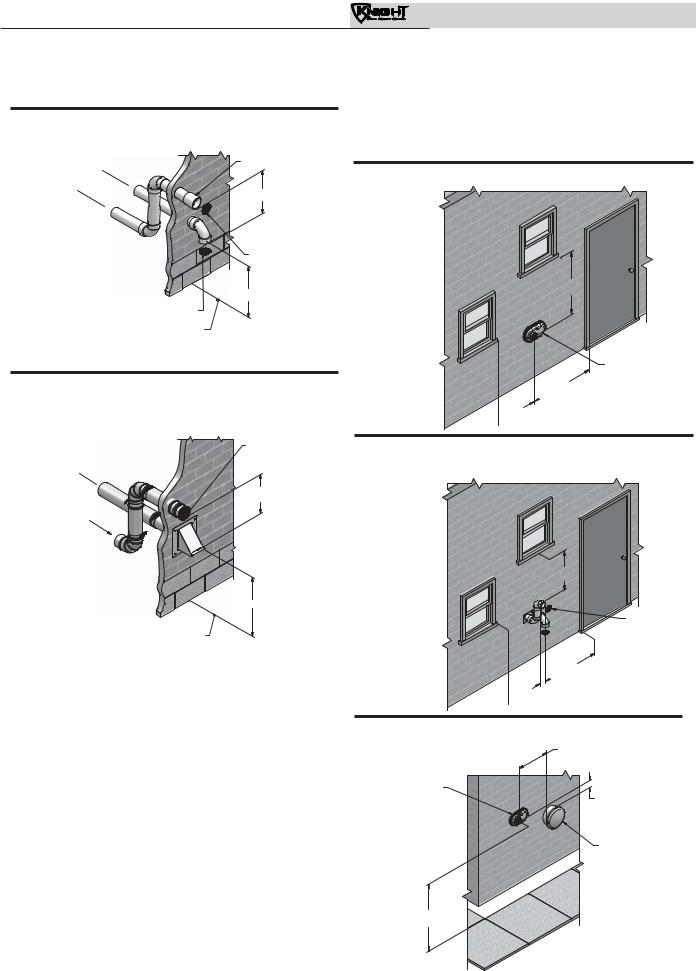
Installation & Operation Manual
4 Sidewall direct venting (continued)
Vent/air termination – sidewall
Figure 4-1C Alternate PVC/CPVC/SS/ Polypropylene Venting Arrangement (if Space Allows) w/Field Supplied Fittings
TO BOILER
INTAKE AIR COUPLING
 CONNECTION
CONNECTION
12” MIN
15” MAX
FROM BOILER 
VENT PIPE
CONNECTION
BIRD SCREEN
12”
MIN
BIRD
SCREEN
GRADE OR
SNOW LINE
ALTERNATE VENTING ARRANGEMENT
(IF SPACE PERMITS)
Figure 4-1D Alternate SS Venting Arrangement - Typical Stainless Steel Sidewall Termination of Air and Vent w/Field Supplied Fittings, Utilizing a Hood Intake
6.Locate terminations so they are not likely to be damaged by foreign objects, such as stones or balls, or subject to buildup of leaves or sediment.
Figure 4-2A Clearance to Gravity Air Inlets
12"
MIN.
VENT / AIR
TERMINATION
12"  MIN.
MIN.
12"  MIN.
MIN.
BIRD SCREEN
TO BOILER
INTAKE AIR
 CONNECTION
CONNECTION
12" (305 MM) MIN 15" (381 MM) MAX
FROM BOILER
VENT PIPE
CONNECTION
12" (305 MM) MIN
GRADE OR
SNOW LINE
5.Maintain clearances as shown in FIG.’s 4-1A thru 4-3B, pages 22 - 24. Also maintain the following:
a.Vent must terminate:
•At least 6 feet from adjacent walls.
•No closer than 12 inches below roof overhang.
•At least 7 feet above any public walkway.
•At least 3 feet above any forced air intake within 10 feet.
•No closer than 12 inches below or horizontally from any door or window or any other gravity air inlet.
b.Air inlet must terminate at least 12 inches above grade or snow line; at least 12 inches below the vent termination; and the vent pipe must not extend more than 24 inches vertically outside the building as shown in FIG. 4-1B. Condensate could freeze and block vent pipe.
c.Do not terminate closer than 4 feet horizontally from any electric meter, gas meter, regulator, relief valve, or other equipment. Never terminate above or below any of these within 4 feet horizontally.
Figure 4-2B Alternate Clearance to Gravity Air Inlets w/ Field Supplied Fittings
12”
MIN.
BIRD
SCREEN (TYPICAL)
12”  MIN.
MIN.
12”  MIN.
MIN.
Figure 4-3A Clearance to Forced Air Inlets
IF LESS
THAN 10’
VENT / AIR
TERMINATION 36"
MIN.
FORCED AIR
INLET
7' MIN. ABOVE ANY PUBLIC WALKWAY
 23
23 
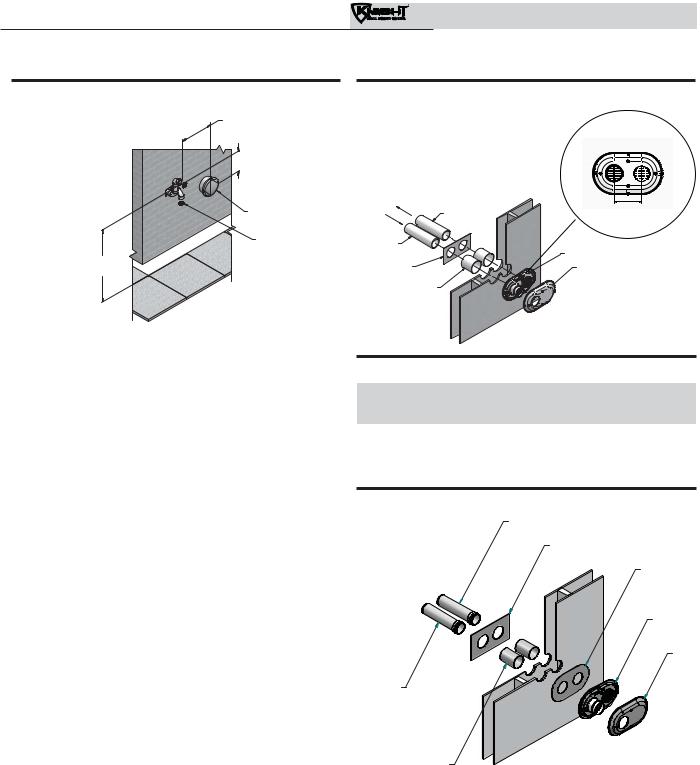
4 Sidewall direct venting
Figure 4-3B Alternate Clearance to Forced Air Inlets w/ Field Supplied Fittings
IF LESS
THAN 10’
Installation & Operation Manual
Figure 4-4A PVC/CPVC Sidewall Termination Assembly
36”
MIN.
FORCED AIR
INLET
BIRD
SCREEN
(TYPICAL)
7’ MIN. ABOVE ANY
PUBLIC WALKWAY
Prepare wall penetrations
1.Use the factory supplied wall plate as a template to locate the vent and air intake holes and mounting holes.
Air pipe penetration:
a.Cut a hole for the air pipe. Size the air pipe hole as close as desired to the air pipe outside diameter.
Vent pipe penetration:
a.Cut a hole for the vent pipe. For either combustible or noncombustible construction, size the vent pipe hole with at least a 1/2 inch clearance around the vent pipe outer diameter:
•4½ inch hole for 3 inch vent pipe
•5½ inch hole for 4 inch vent pipe
Drill 3/16" diameter holes for inserting the plastic anchors into the wall.
2.For Polypropylene Only: Install the vent and air intake sidewall adapters from Table 3F on page 20 into the vent plate. Slide the sidewall retaining bracket down the sidewall adapters flush to the vent plate (FIG. 4-4B).
3.For PVC/CPVC Only: Install the vent and air intake piping through the wall into the vent plate openings. Use RTV silicone sealant to seal the air pipe. Use the cement/primer listed in Table 3D on page 19 to seal the vent pipe.
4.Mount and secure the vent plate to the wall, using stainless steel screws.
5.Seal all gaps between the pipes and wall. Seal around the plate to the wall assuring no air gaps.
6.Assemble the vent cap to the vent plate (see FIG.'s 4-4A and 4-4B). Insert the stainless steel screws into the vent cap screw hole openings and securely attach the vent cap to the vent plate.
7.Seal all wall cavities.
8.PVC/CPVC terminations are designed to accommodate any wall thickness of standard constructions per the directions found in this manual.
9.Stainless steel terminations are designed to penetrate walls with a thickness up to 9.25 inches of standard construction.
 24
24 
|
VENT AIR |
AIR PIPING |
CENTERLINE WIDTH |
VENT PIPING |
|
|
VENT PLATE |
WALL PLATE |
VENT CAP |
|
|
GALVANIZED |
|
THIMBLE |
|
Table 4B Sidewall Vent Centerline Dimensions
Model |
Air |
Vent |
Centerline Width |
|
|
|
|
151 - 200 |
3" |
3" |
5 5/8" |
286 |
4" |
4" |
5 5/8" |
Figure 4-4B Polypropylene Sidewall Termination Assembly
SIDEWALL
ADAPTER
(AIR)
WALL
PLATE
SIDEWALL
RETAINING
PLATE
VENT
PLATE
VENT
CAP
SIDEWALL ADAPTER (VENT)
GALVANIZED |
IMG00085 |
THIMBLE |
|
